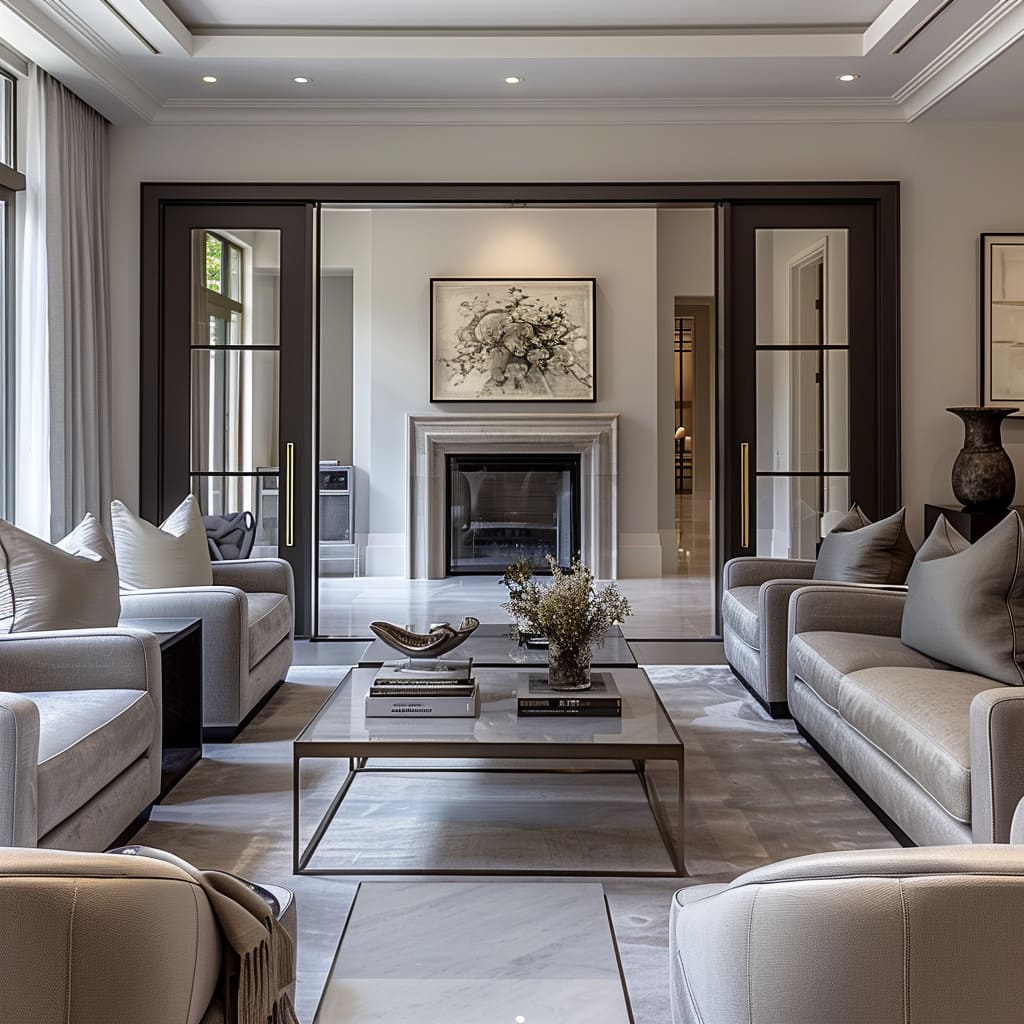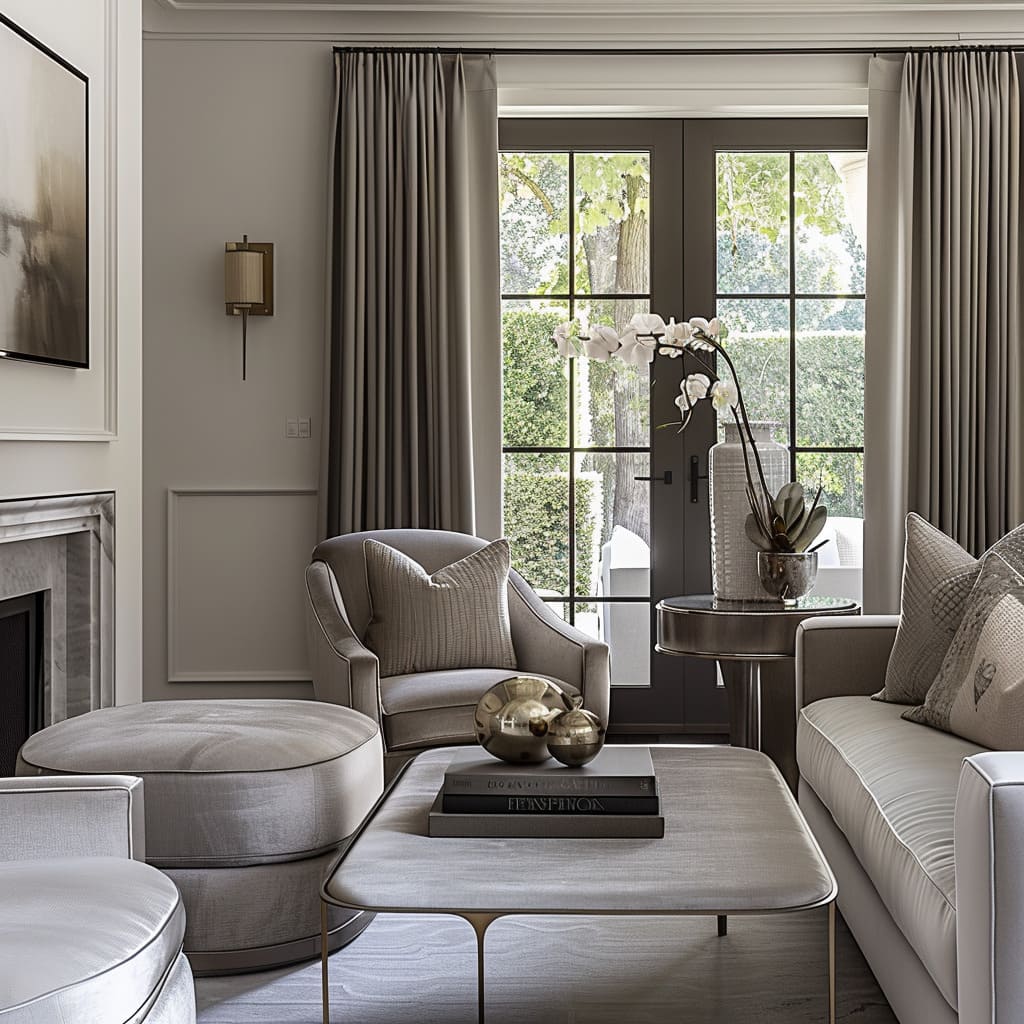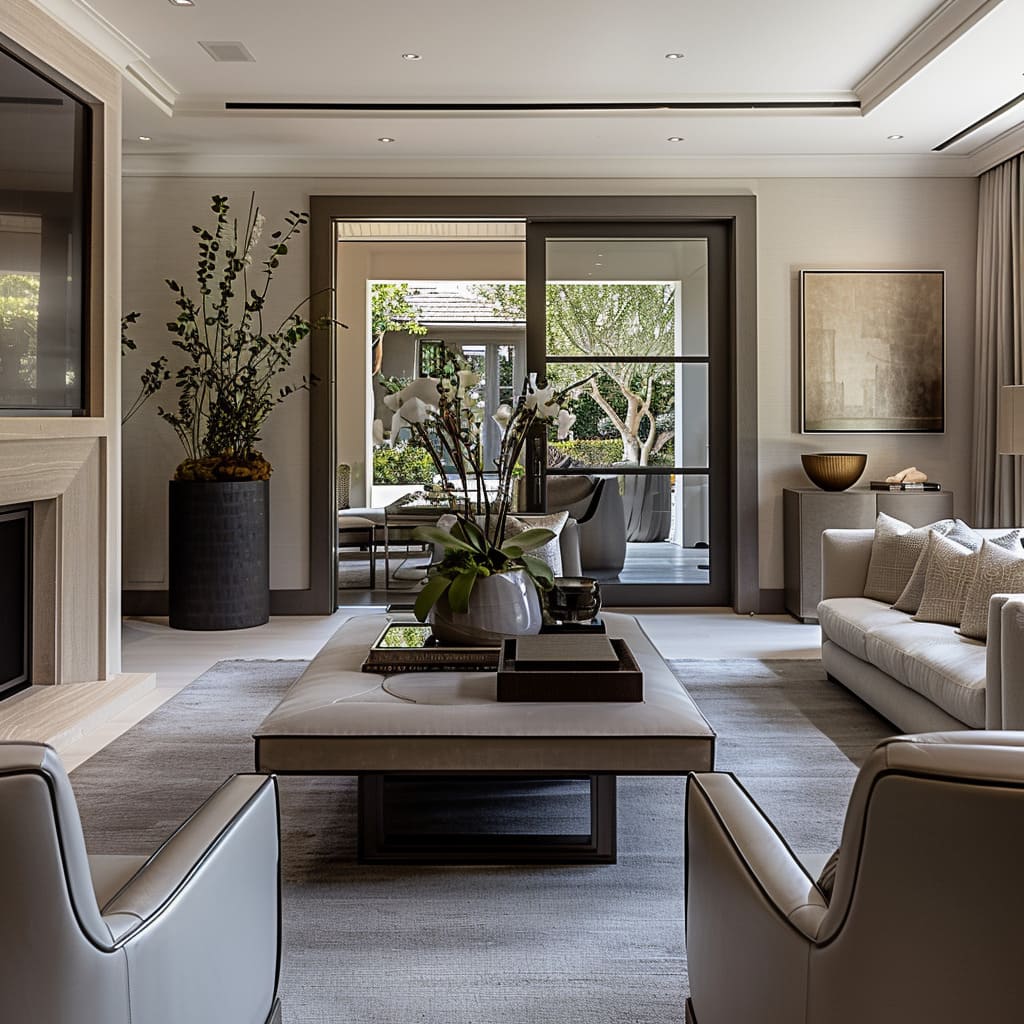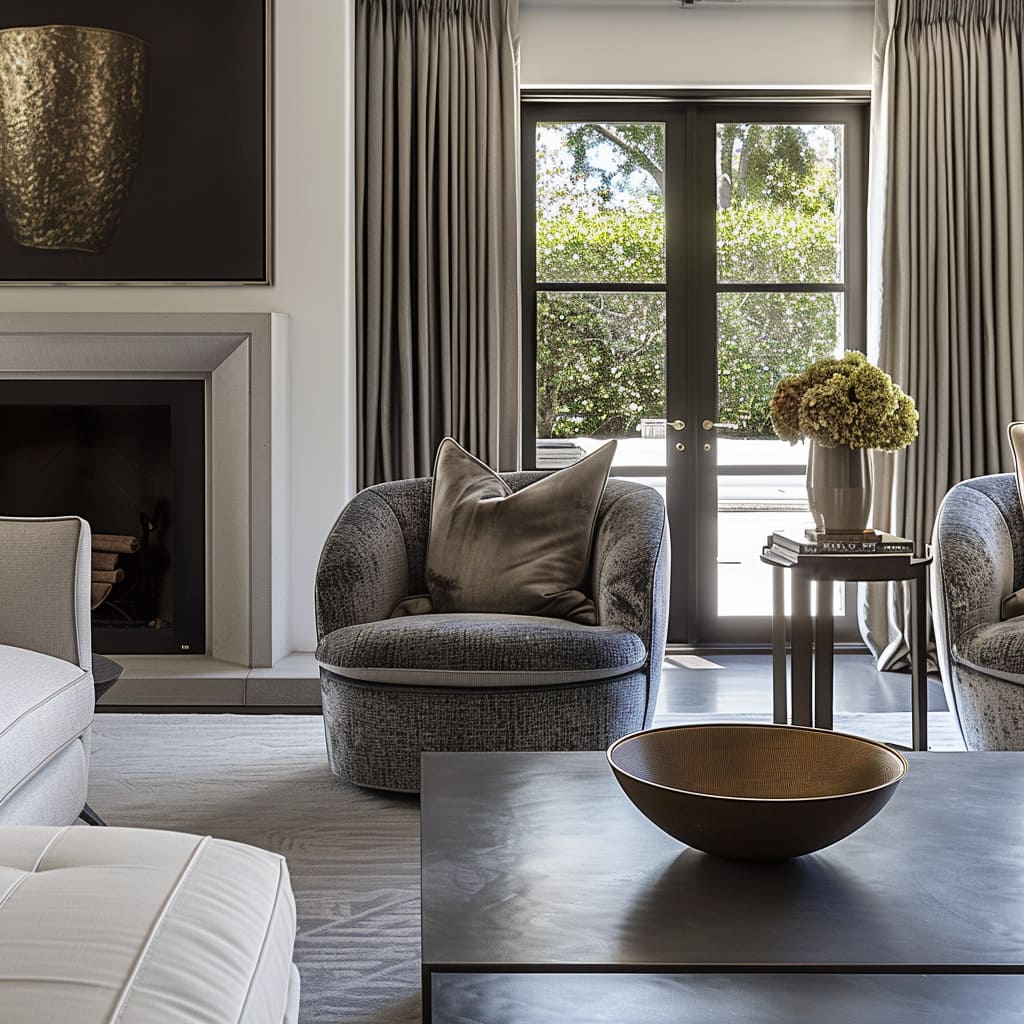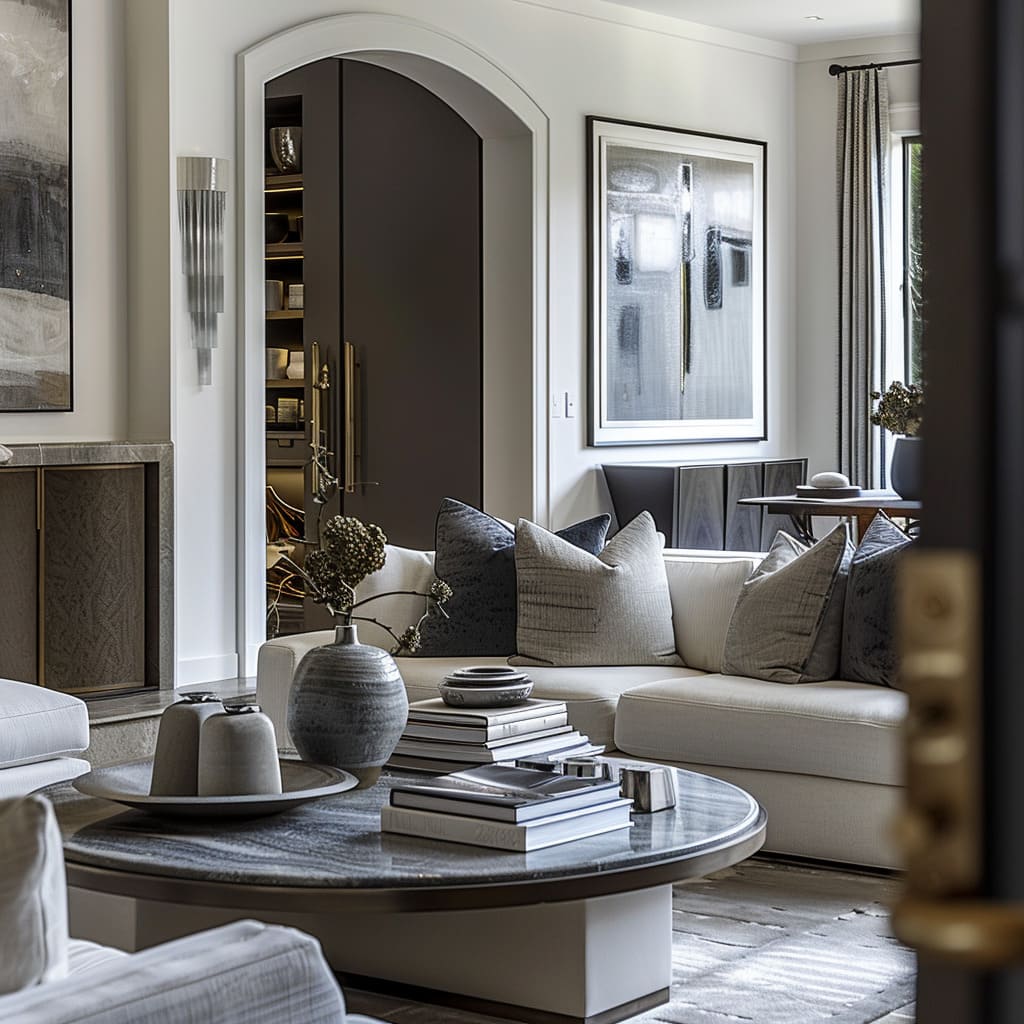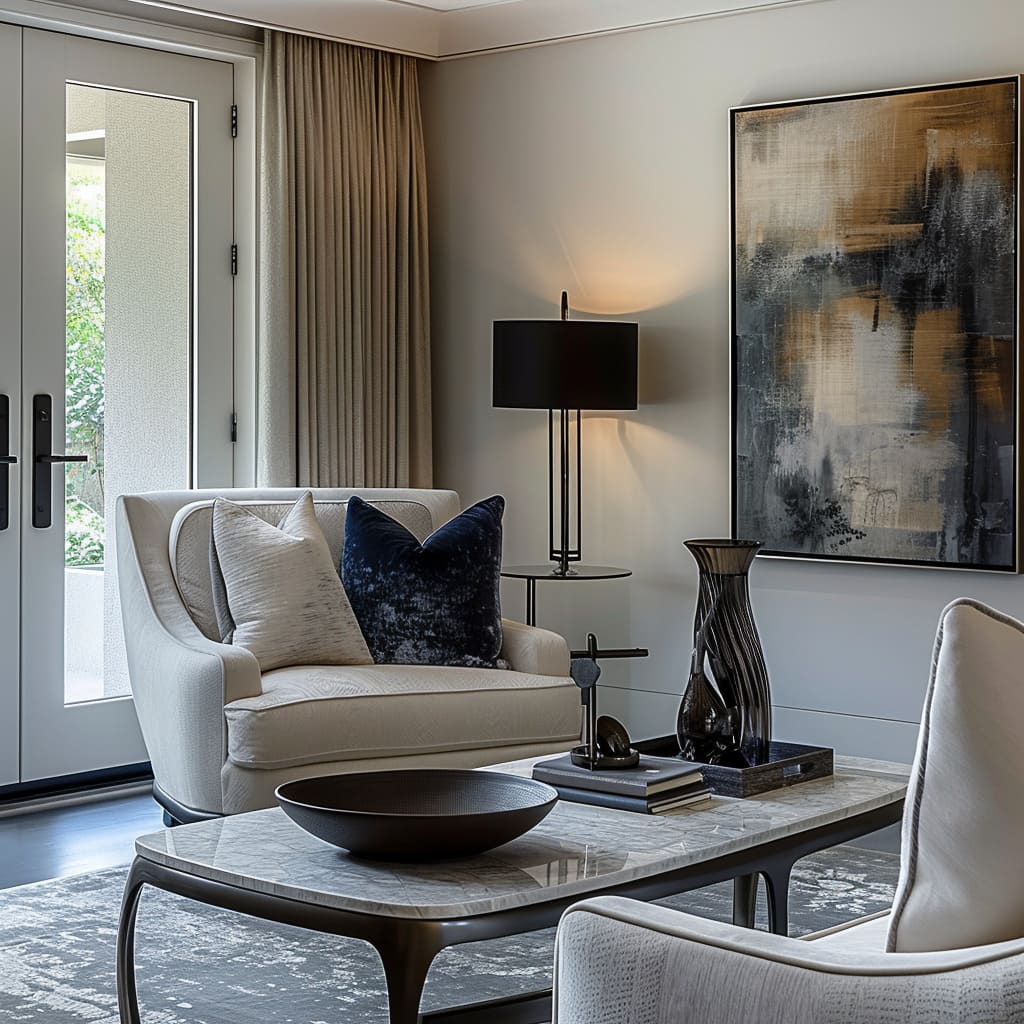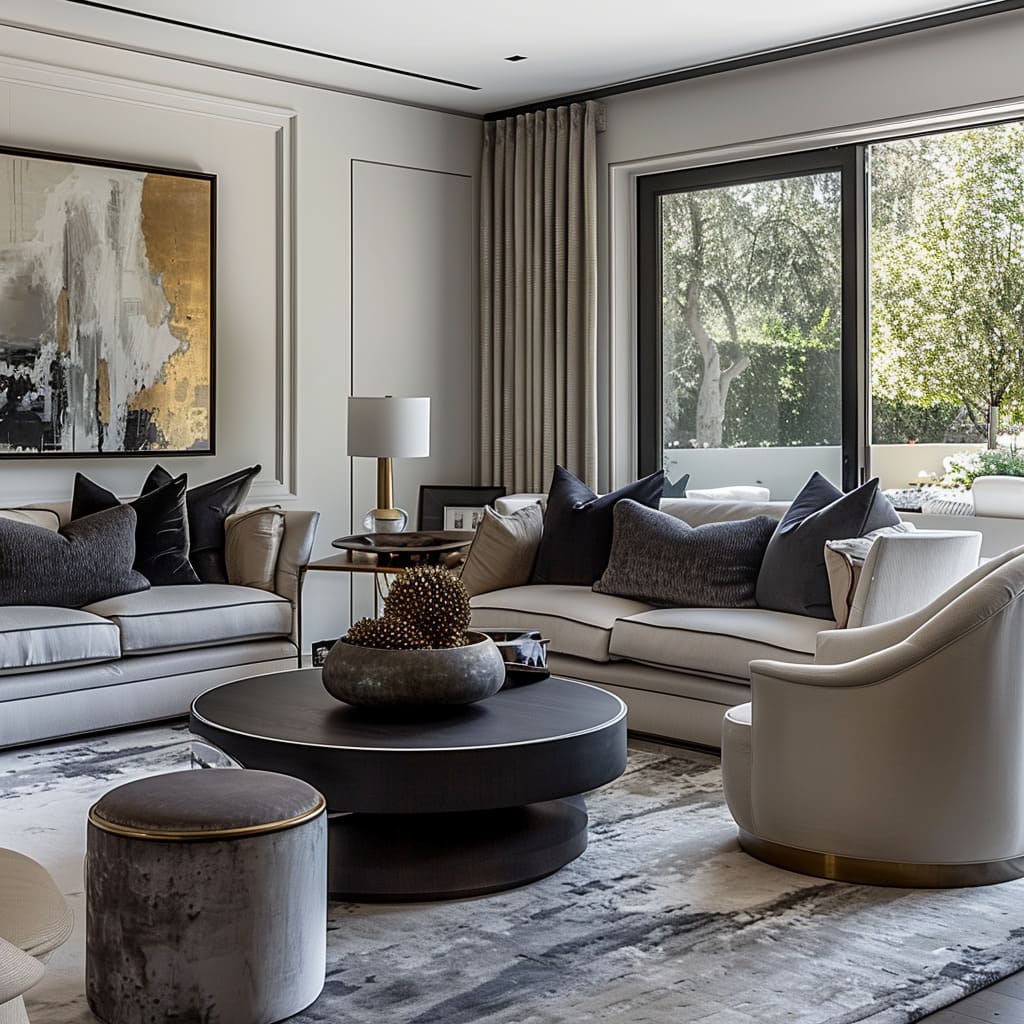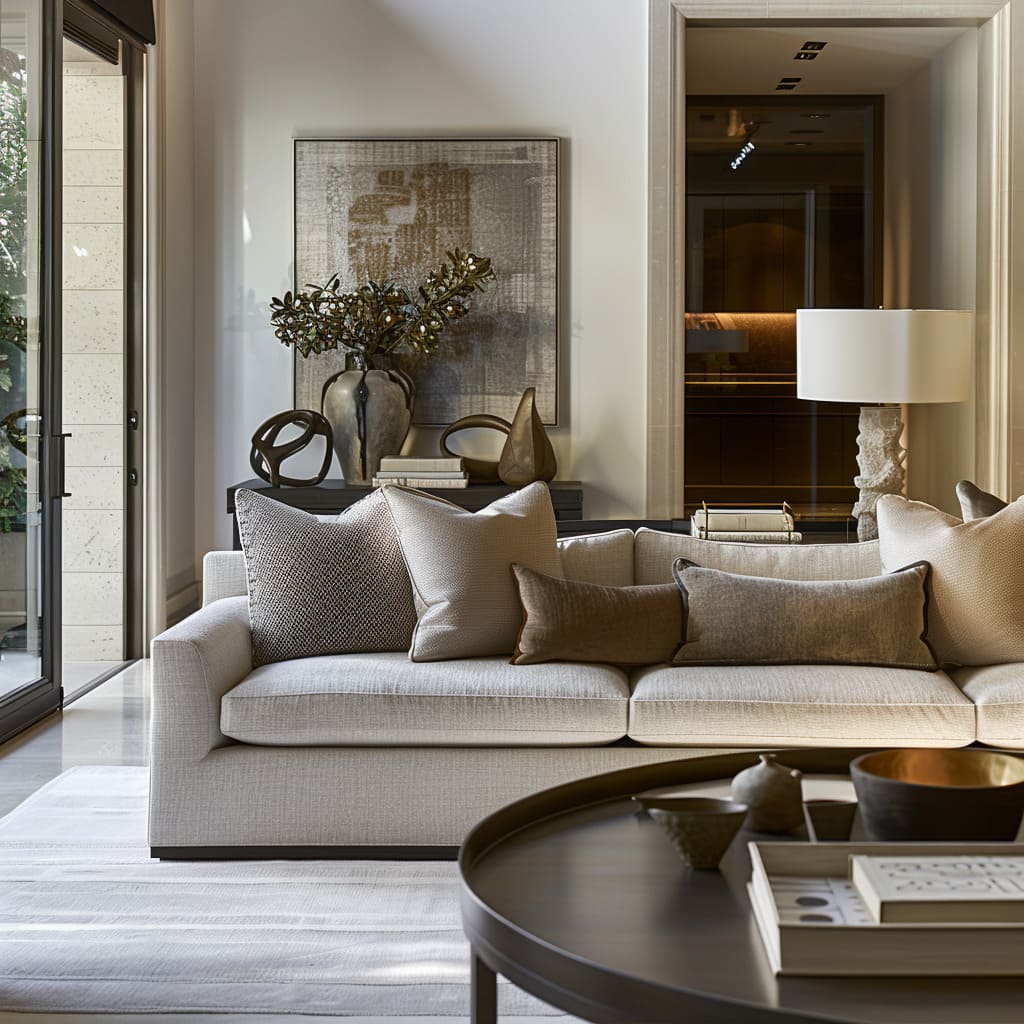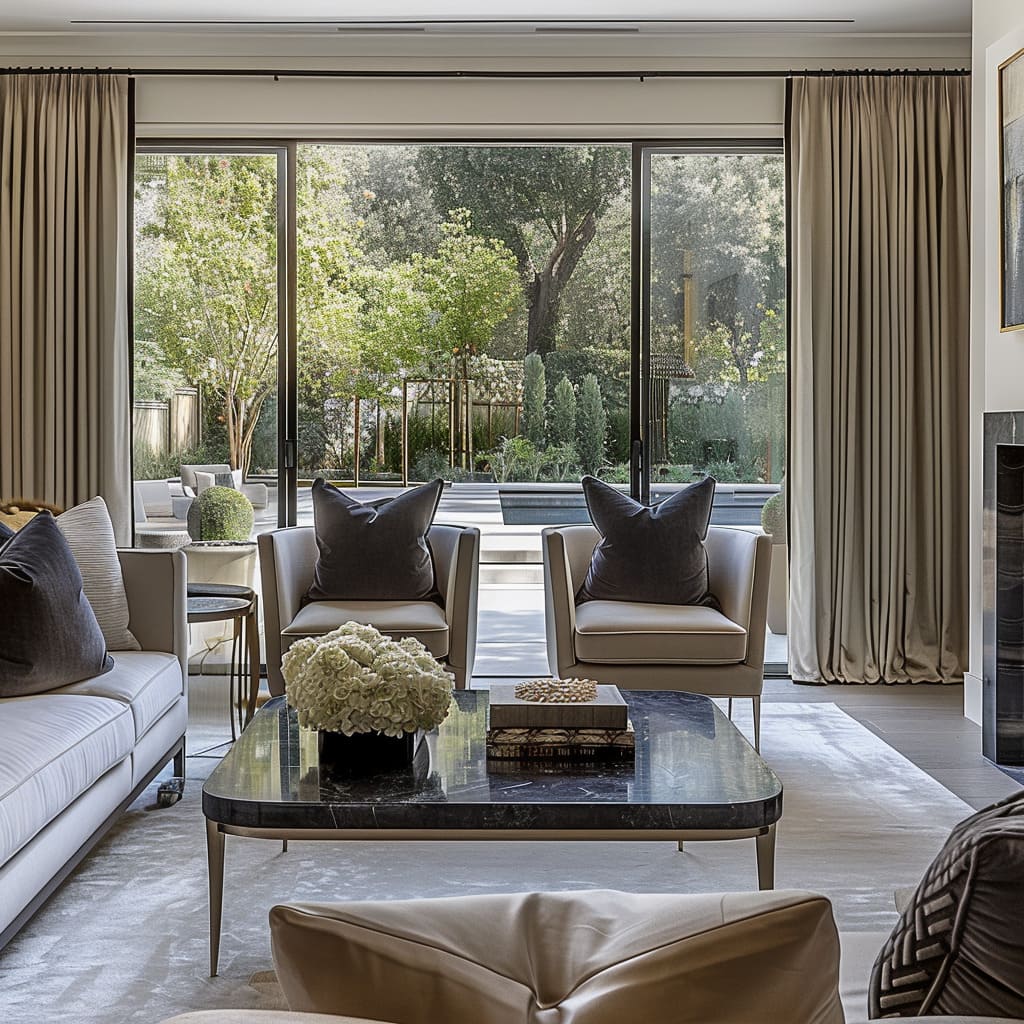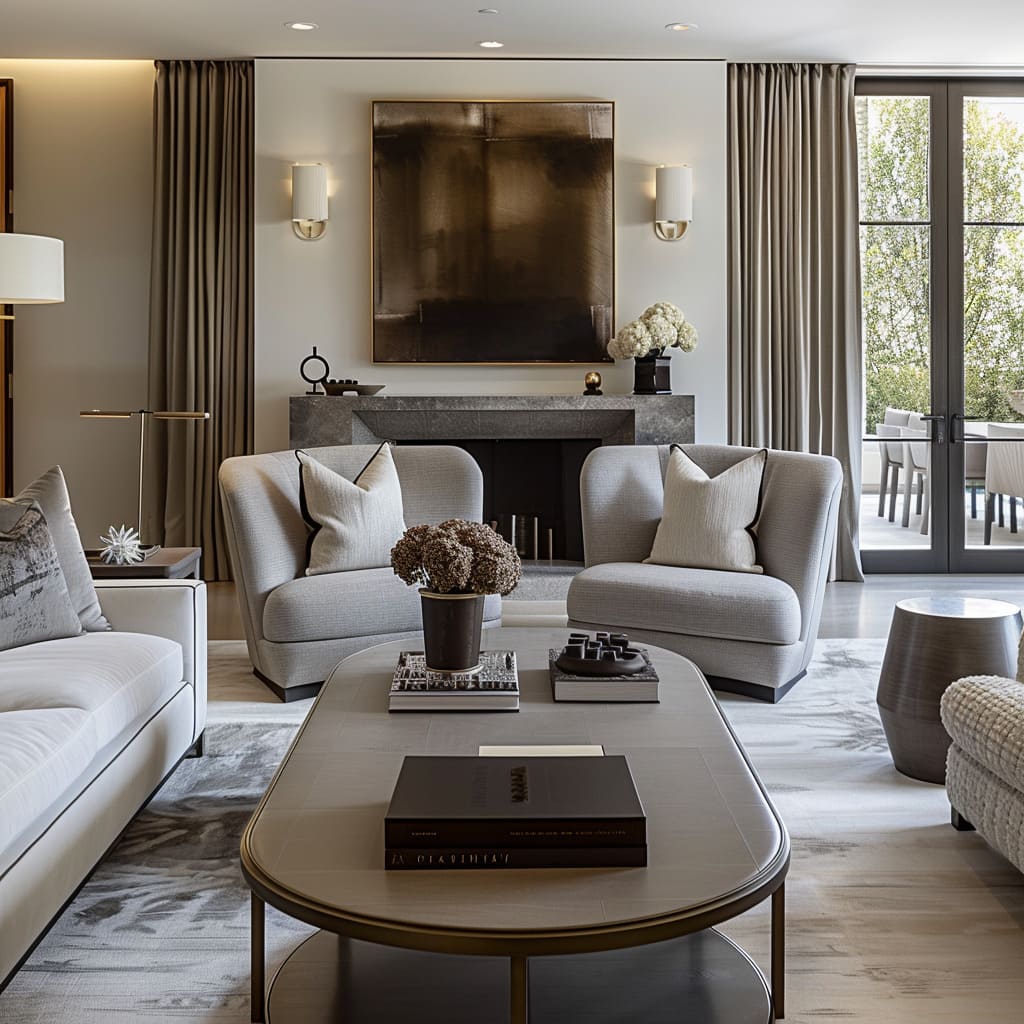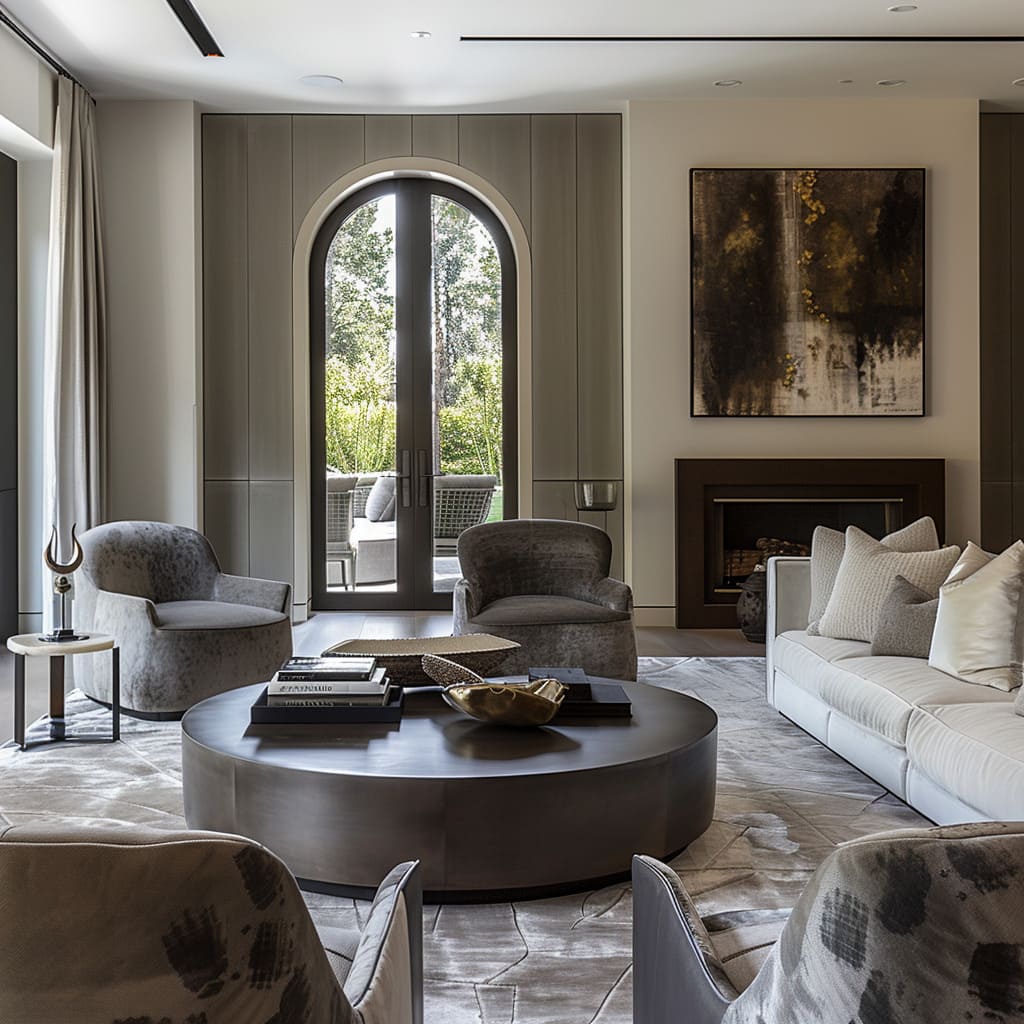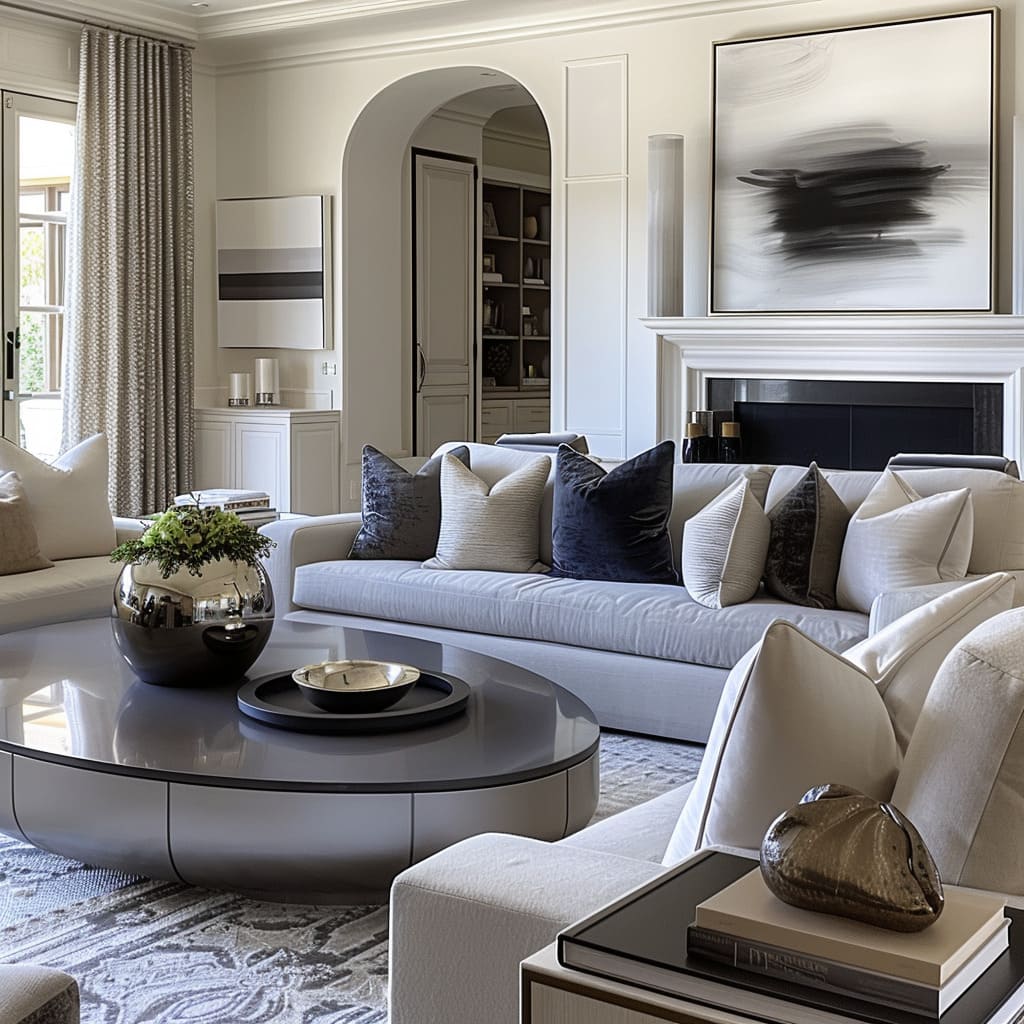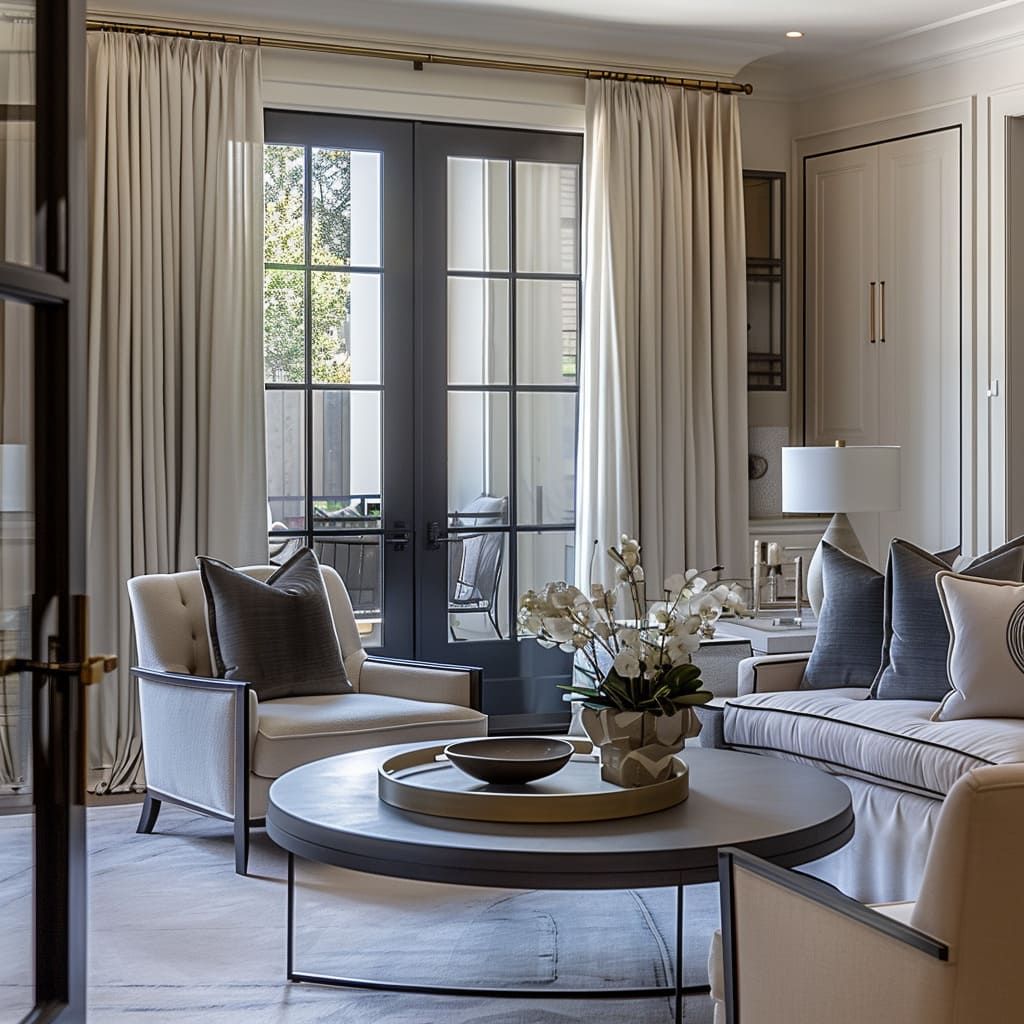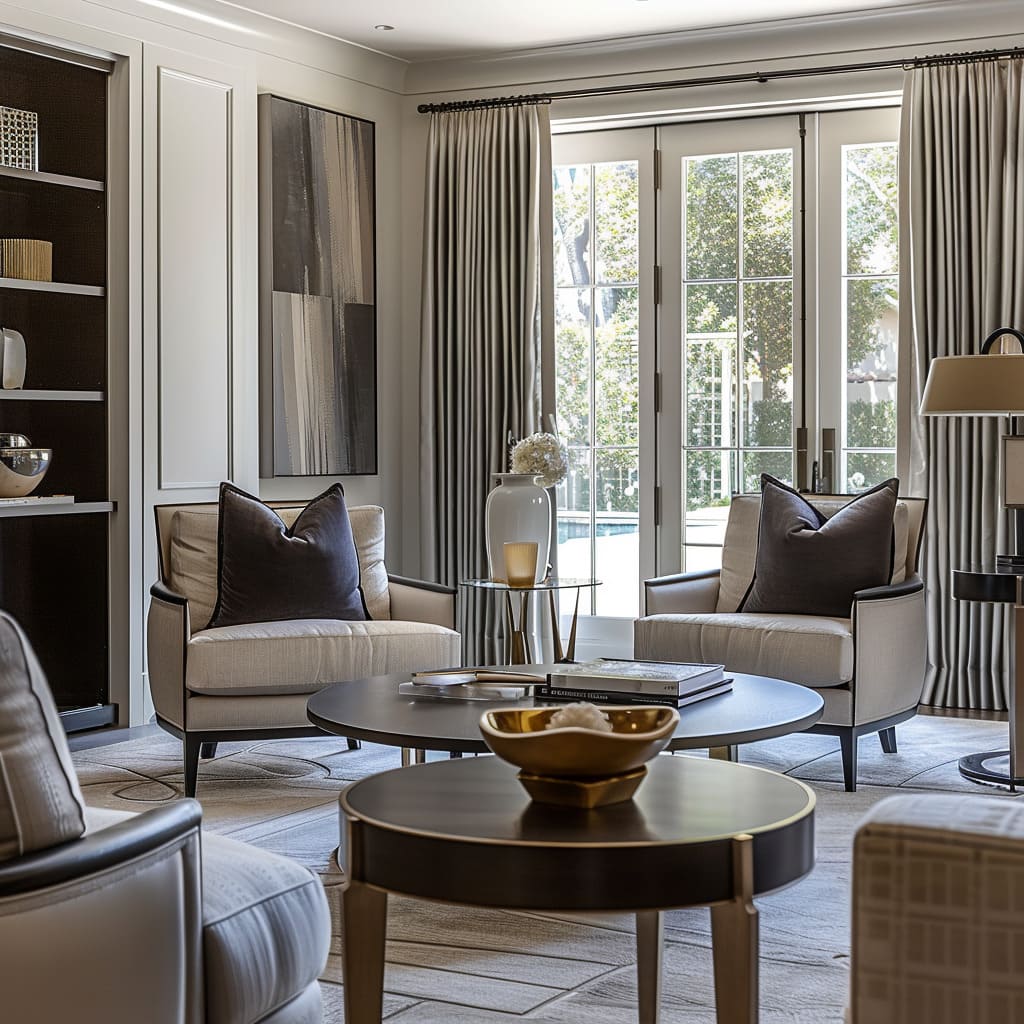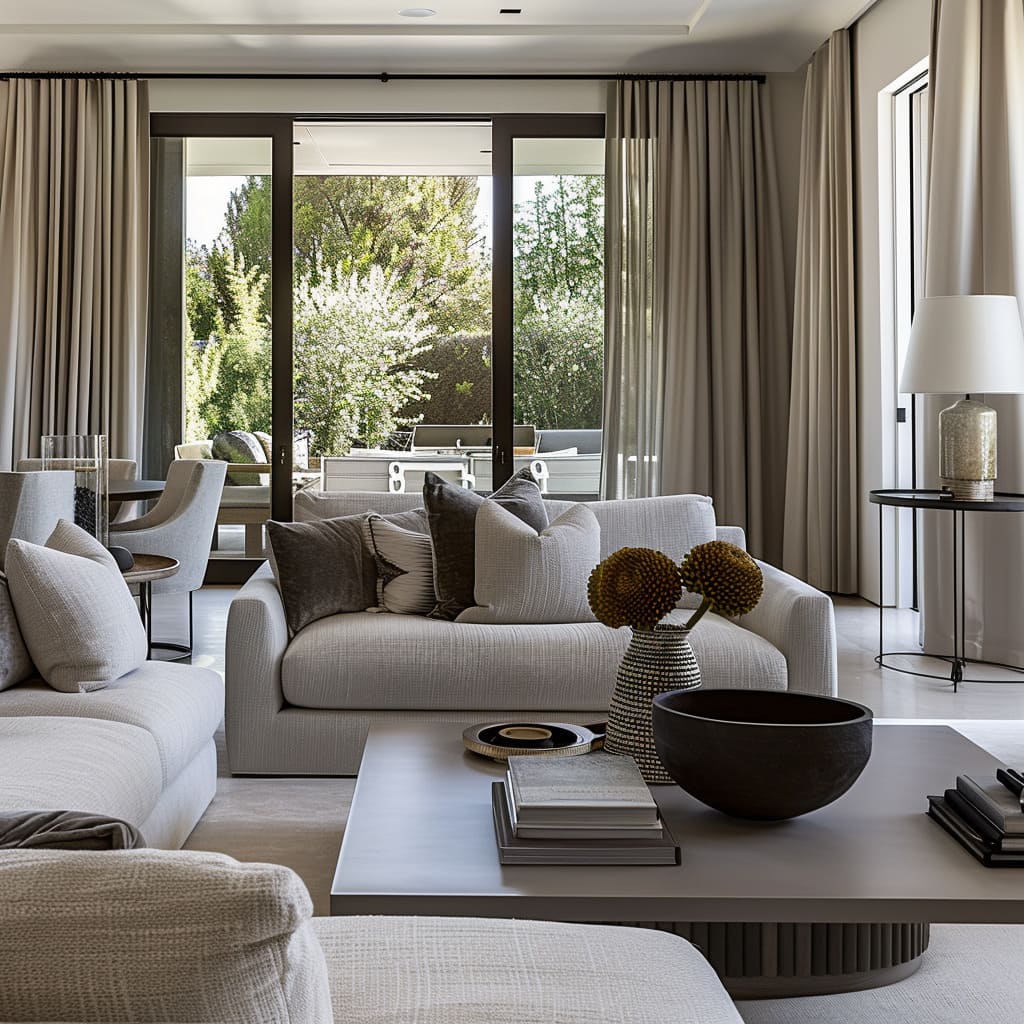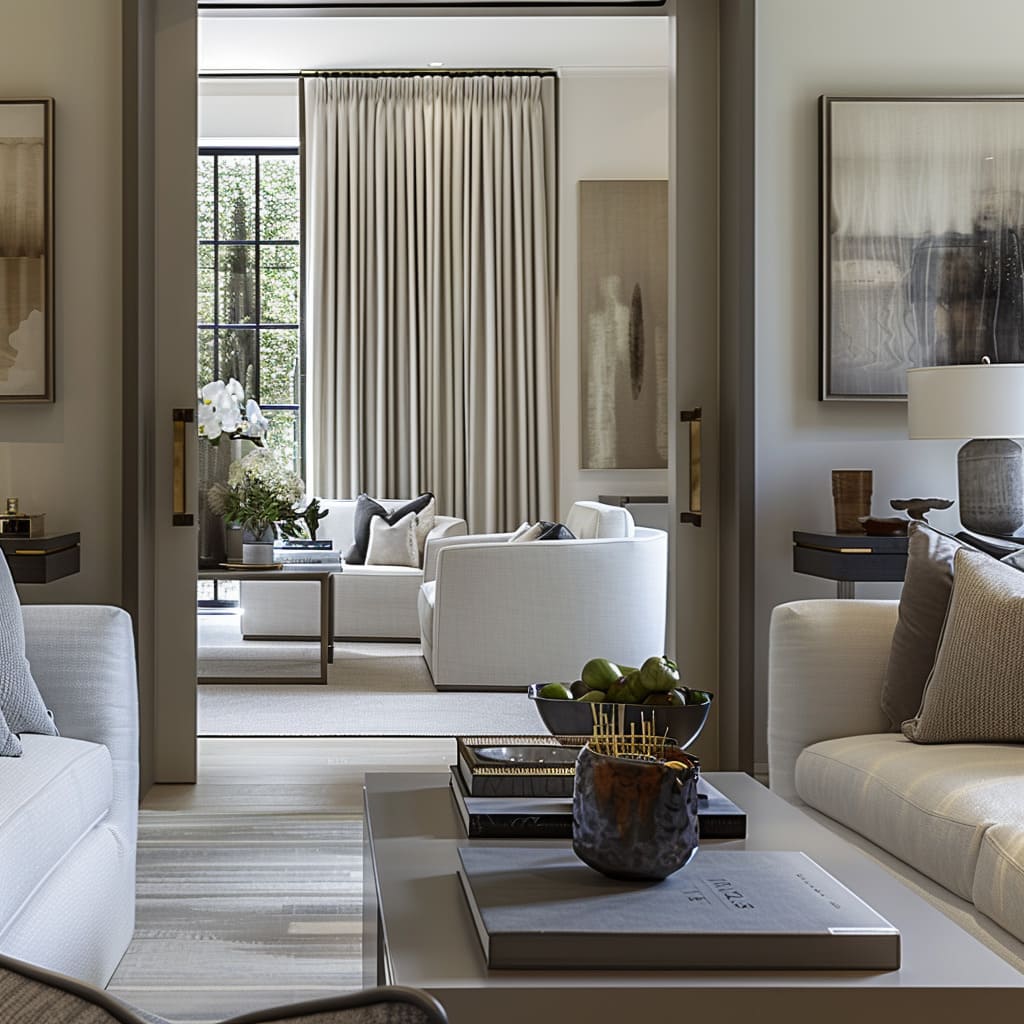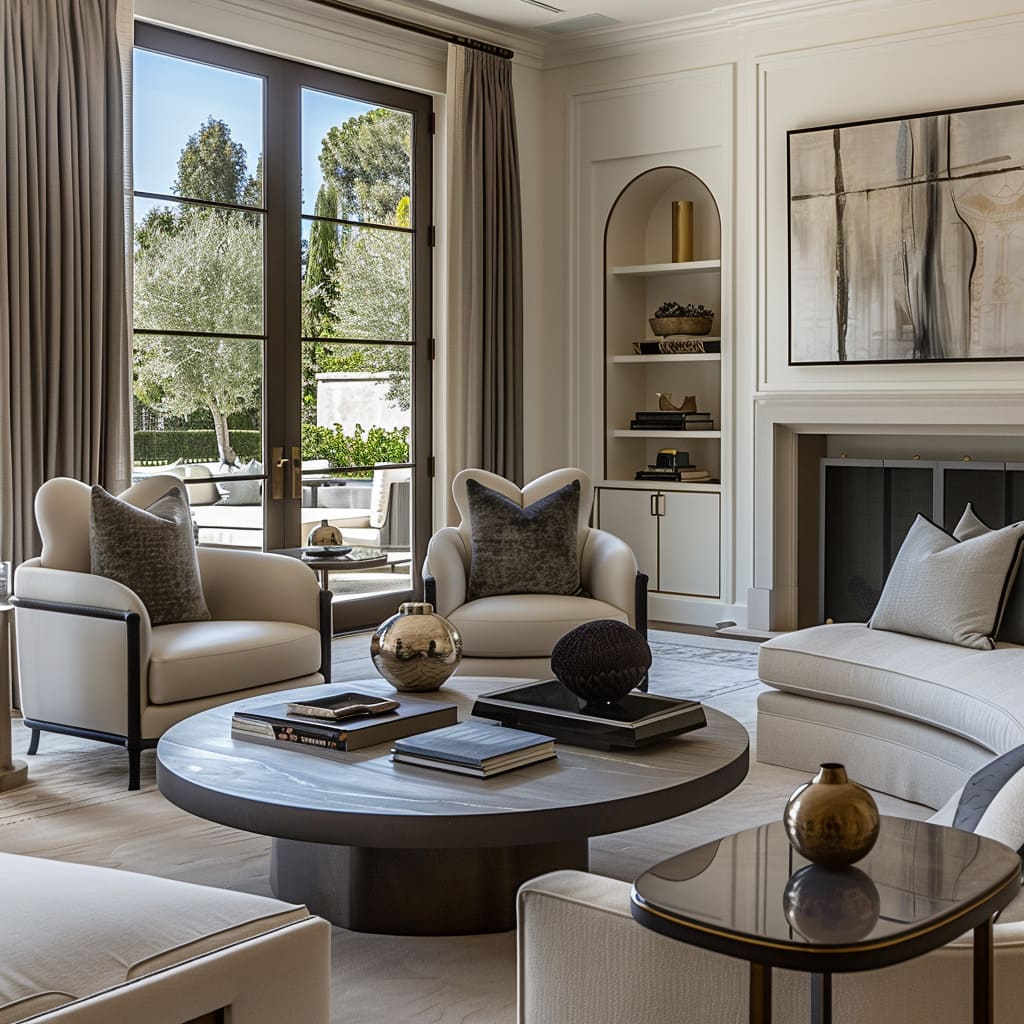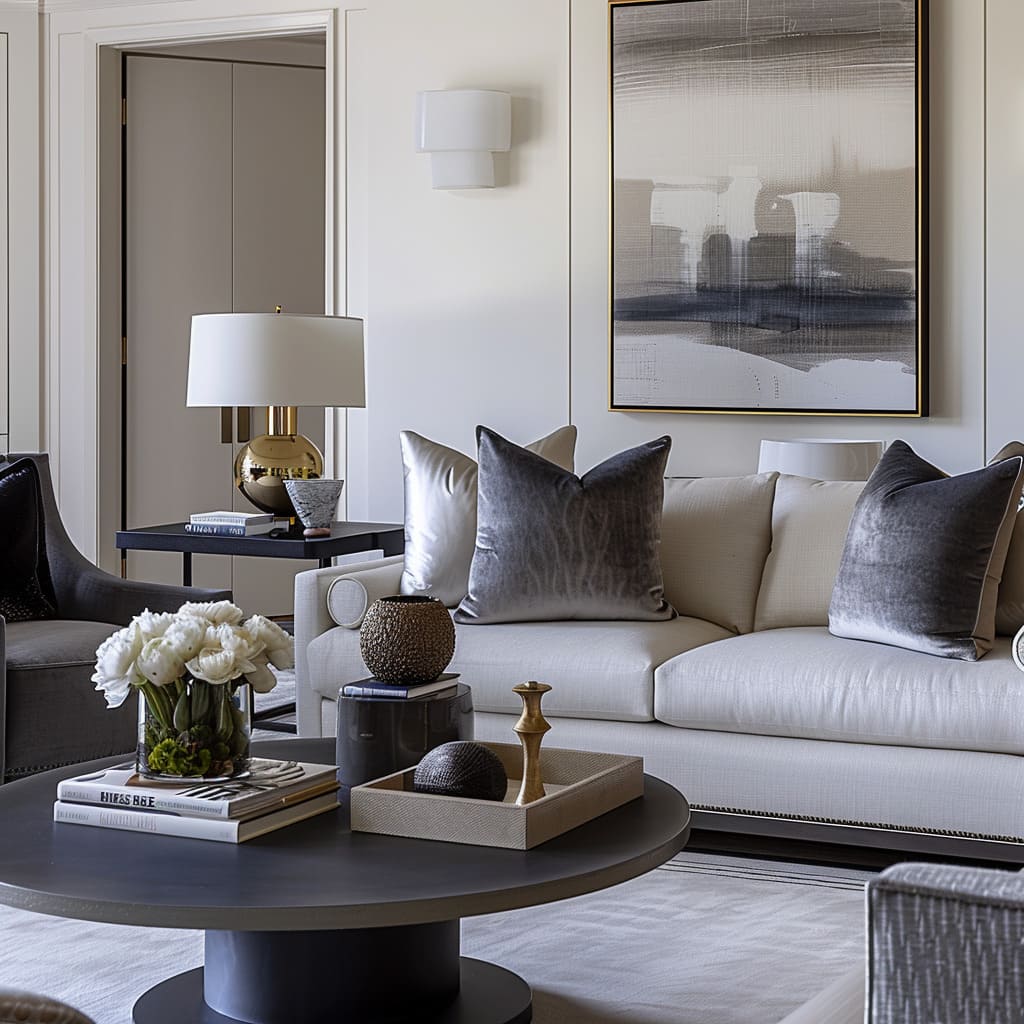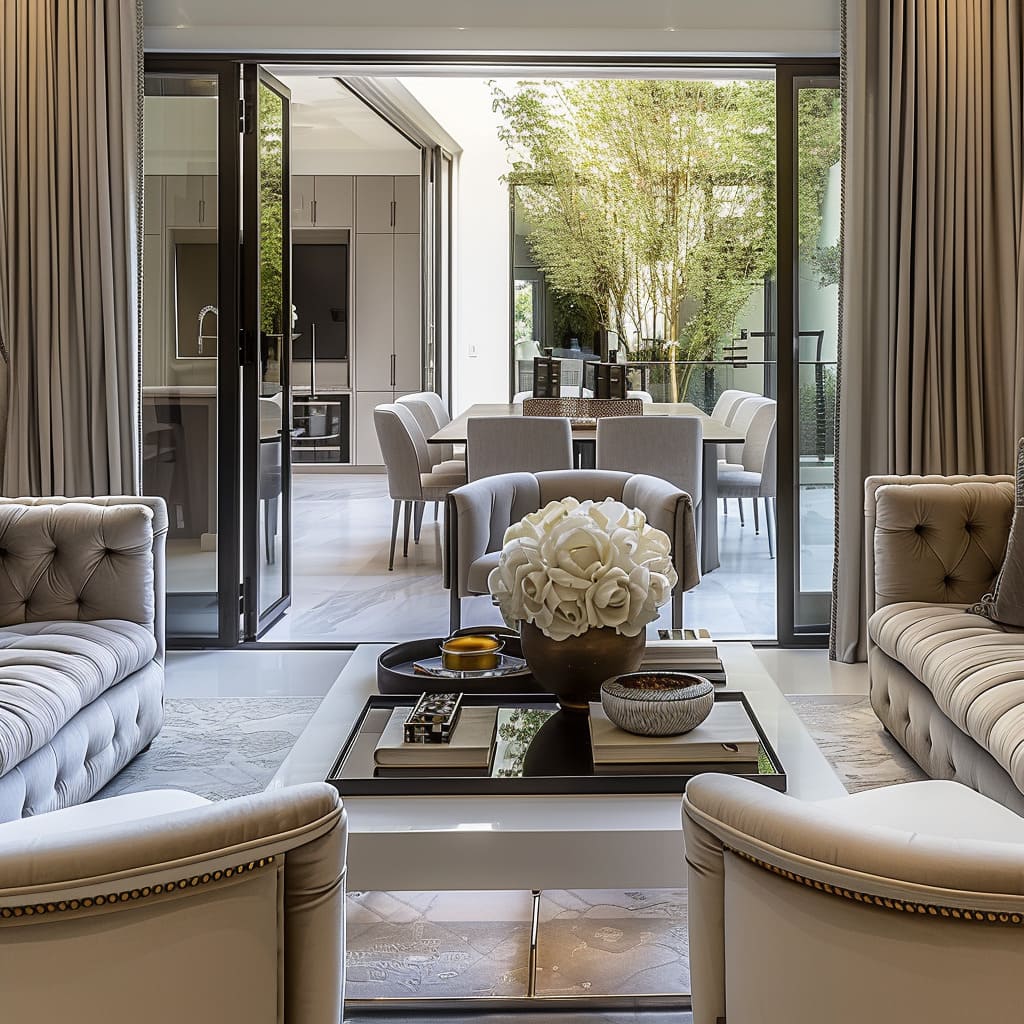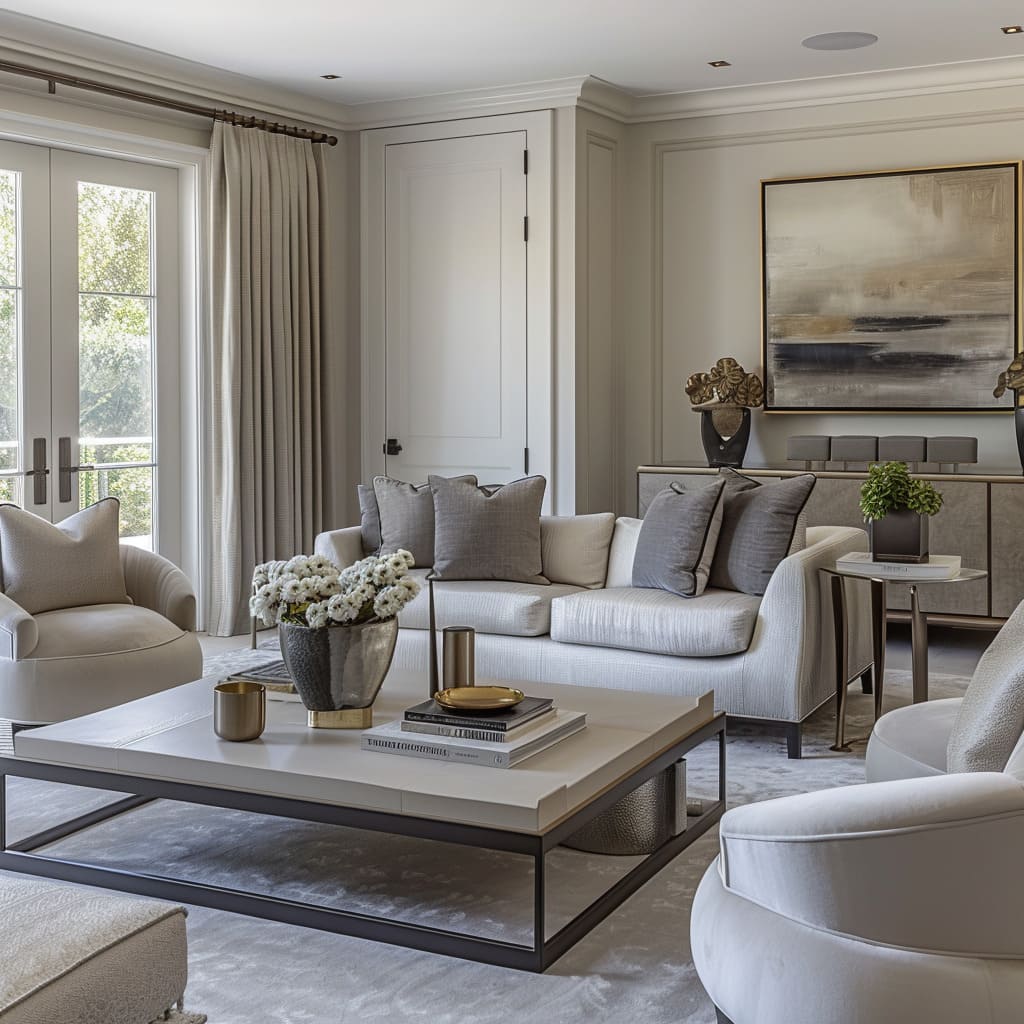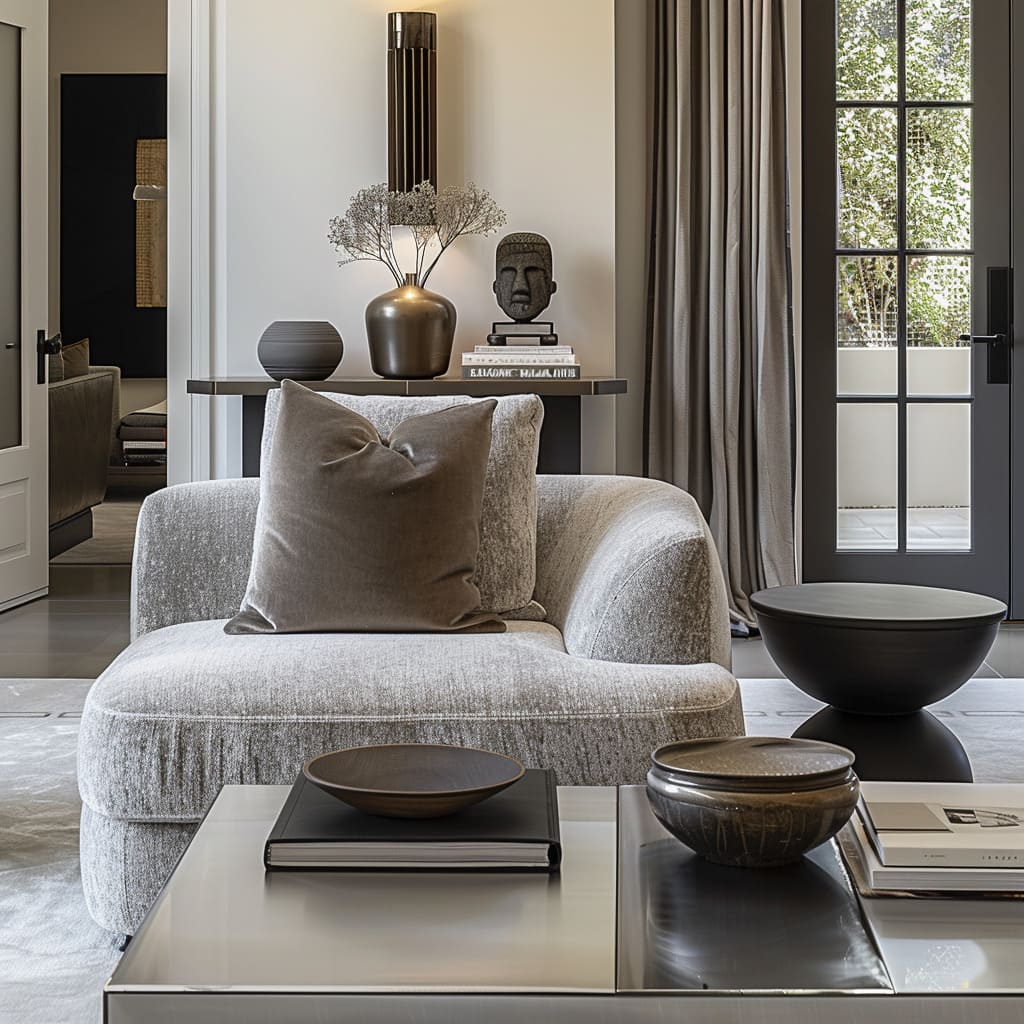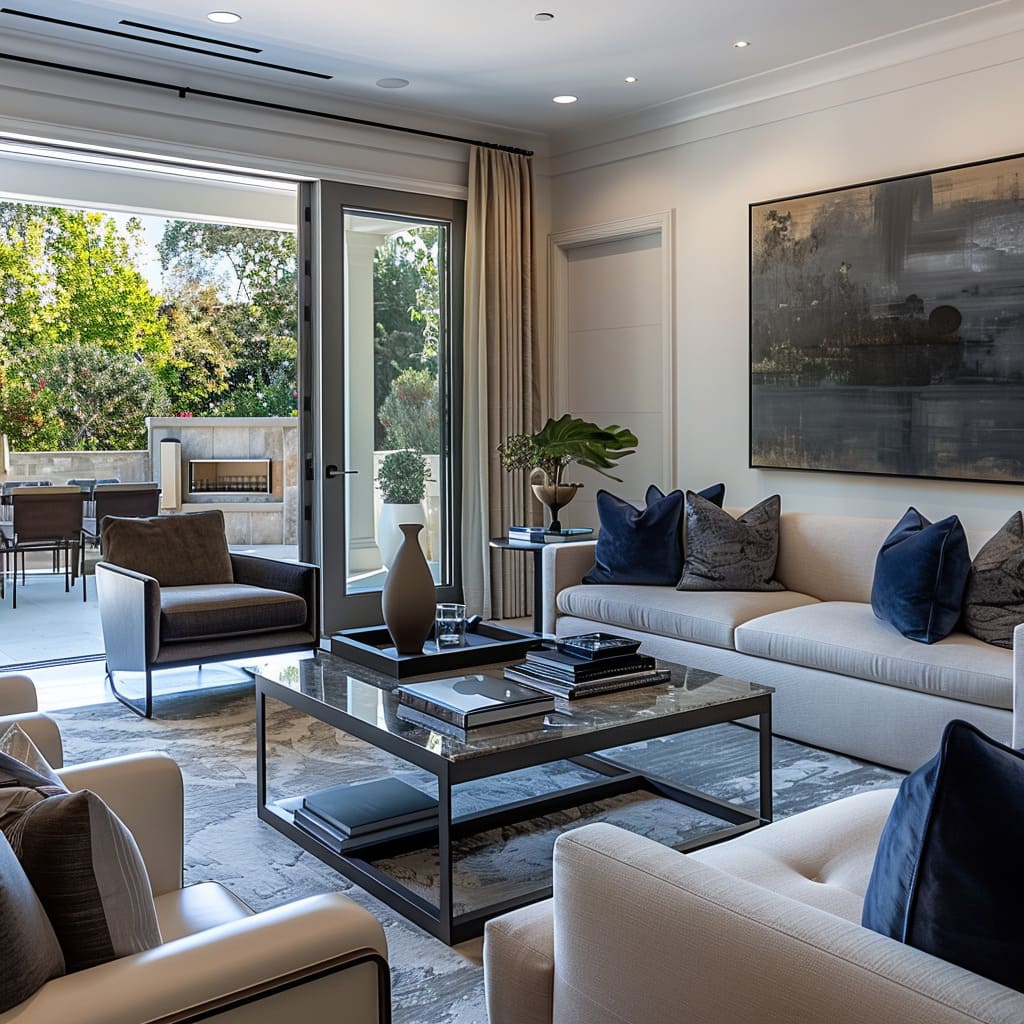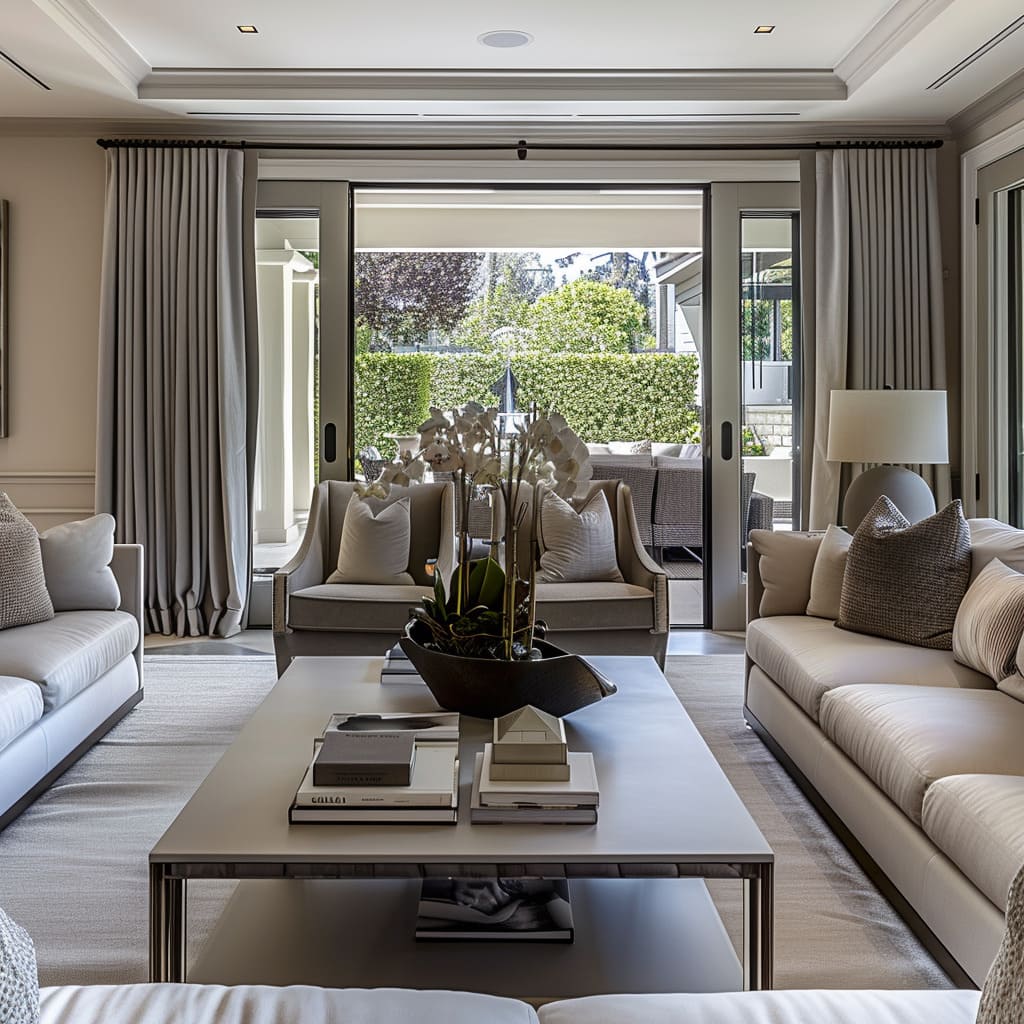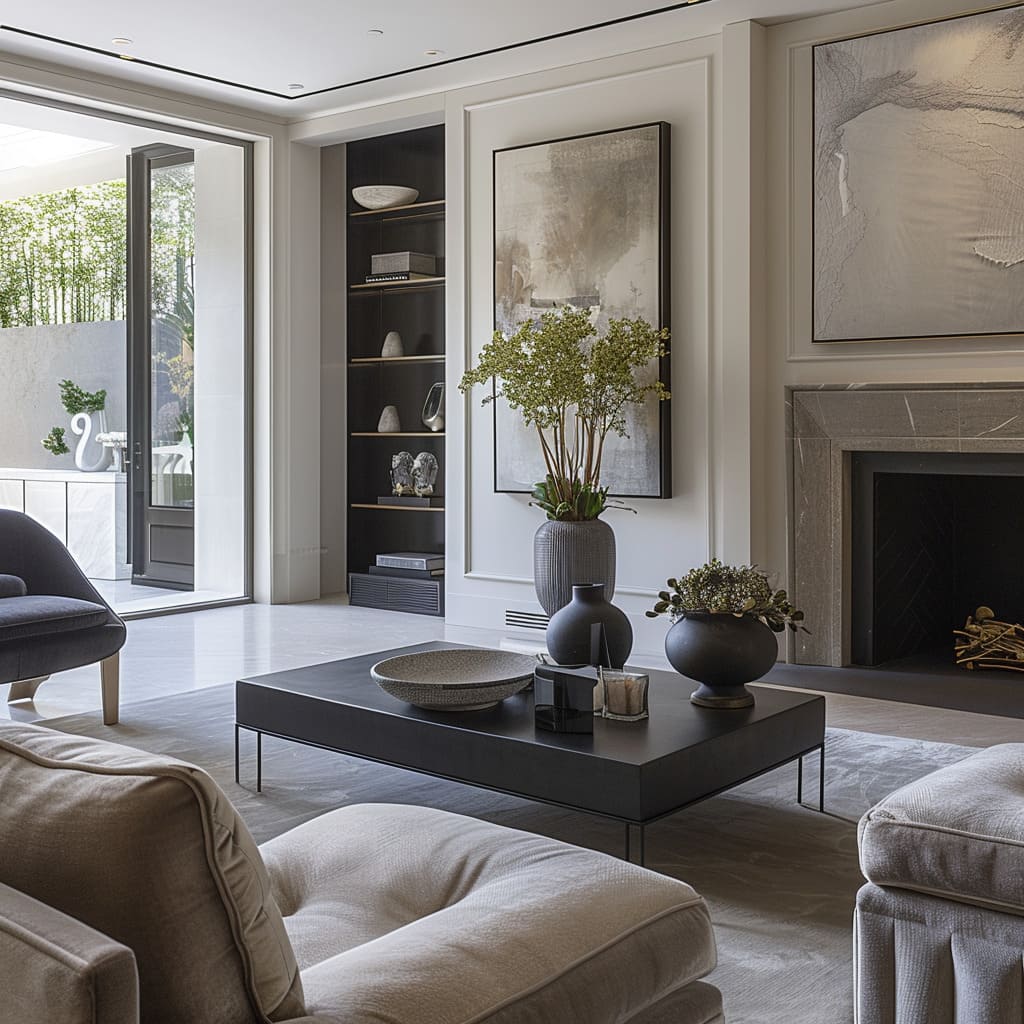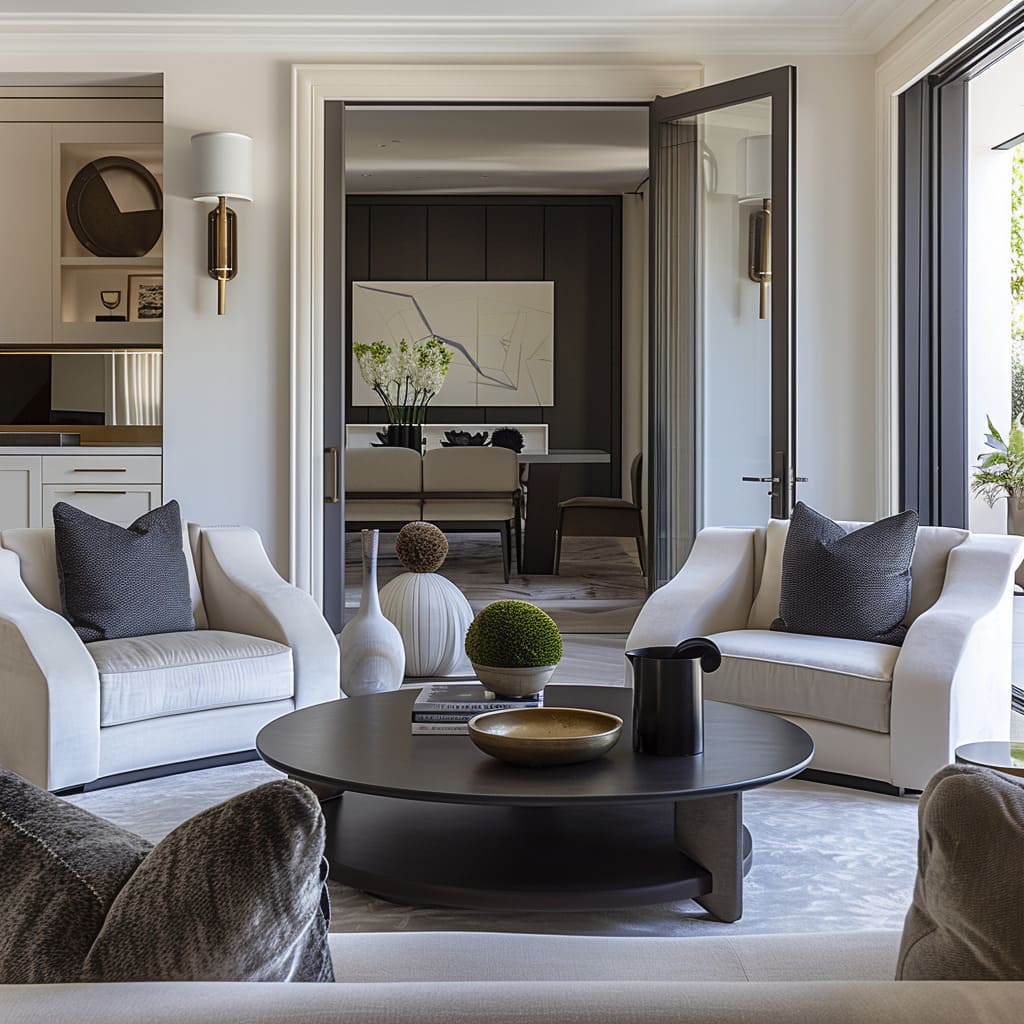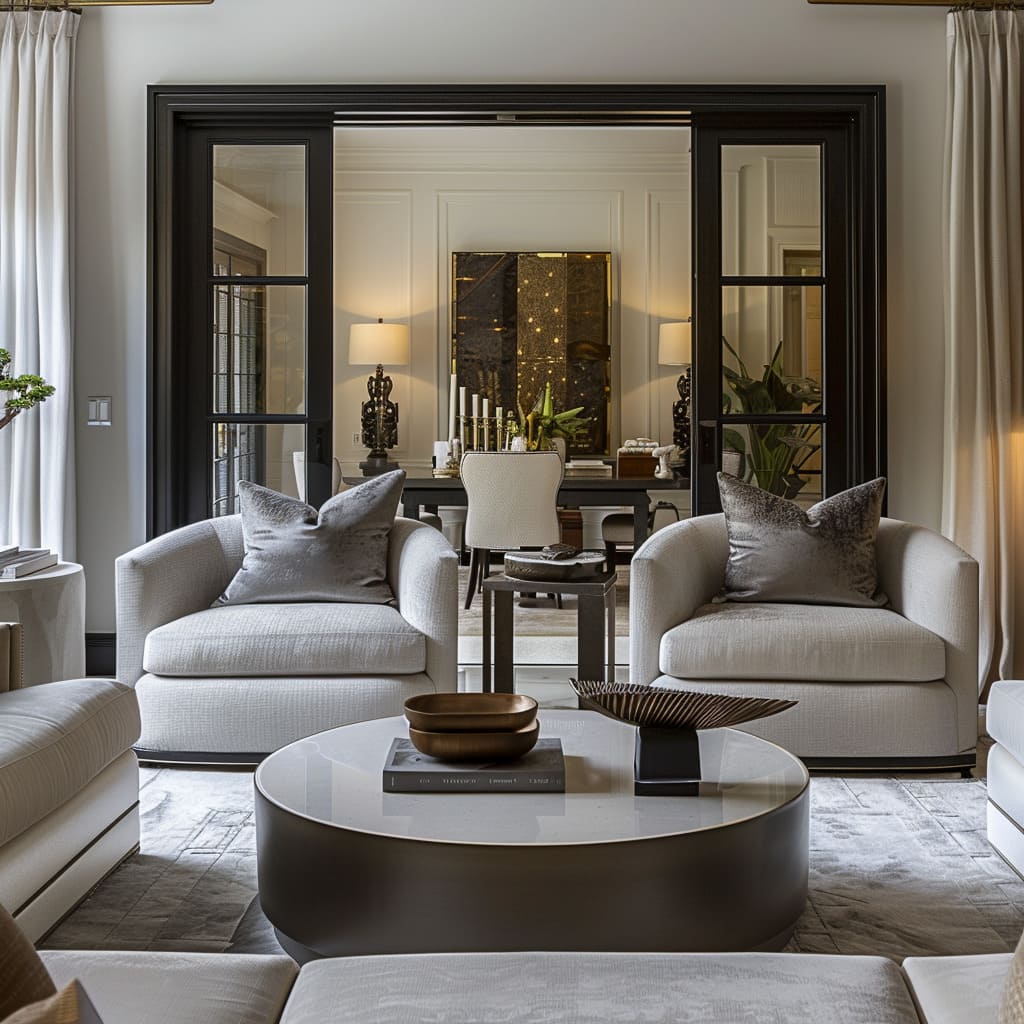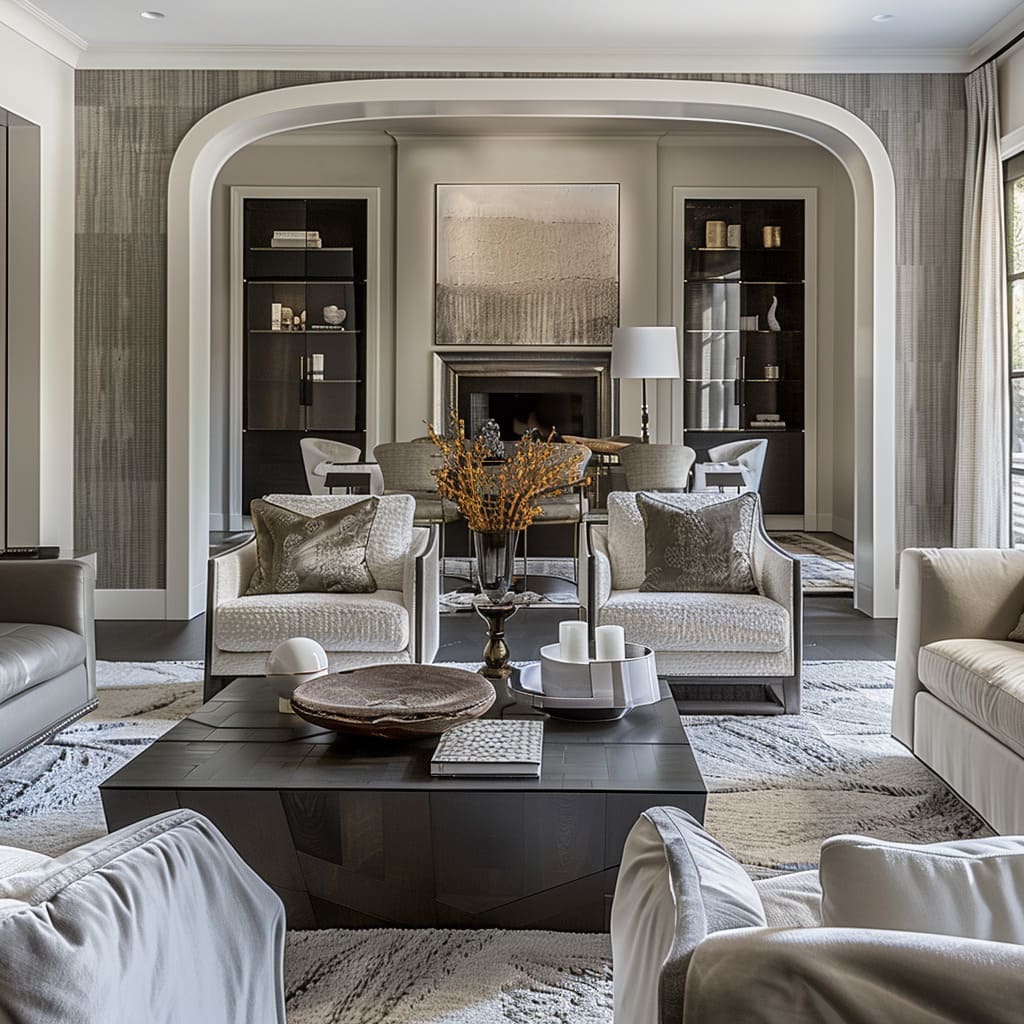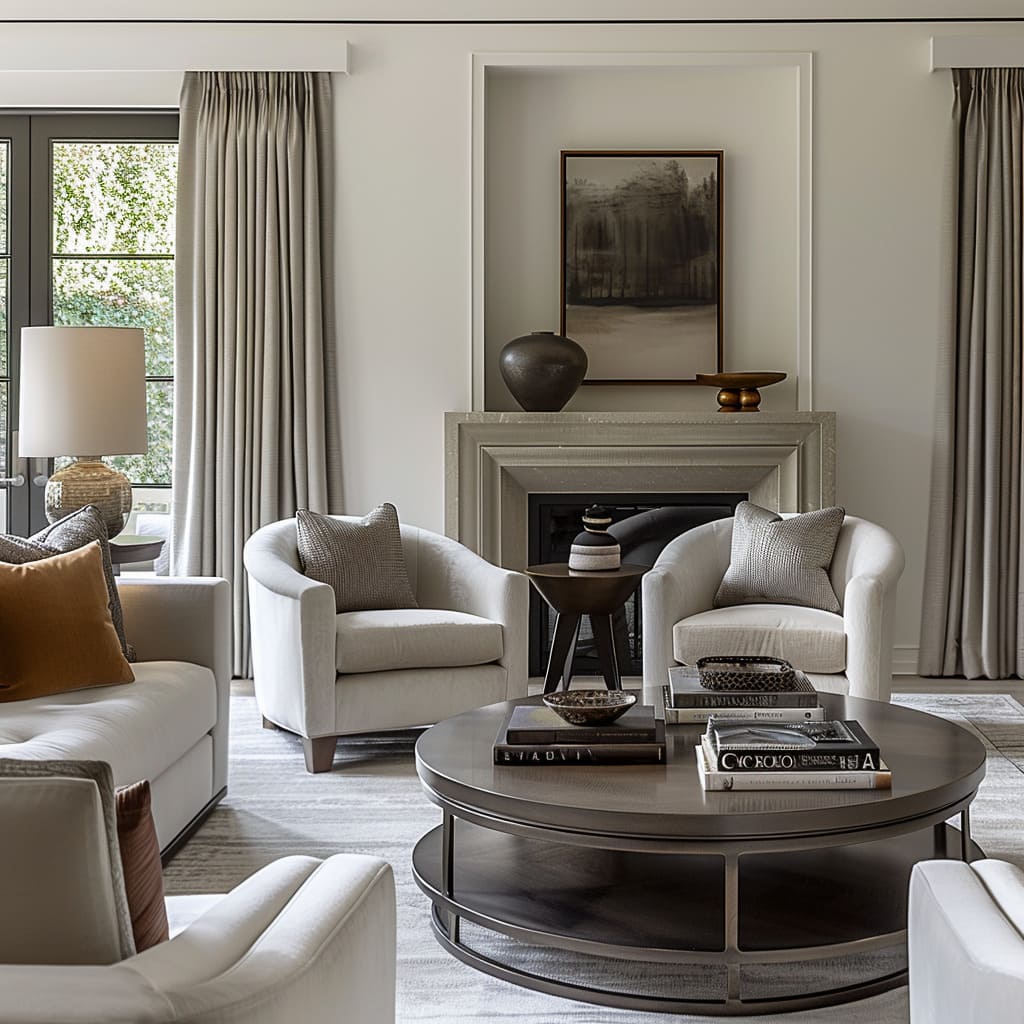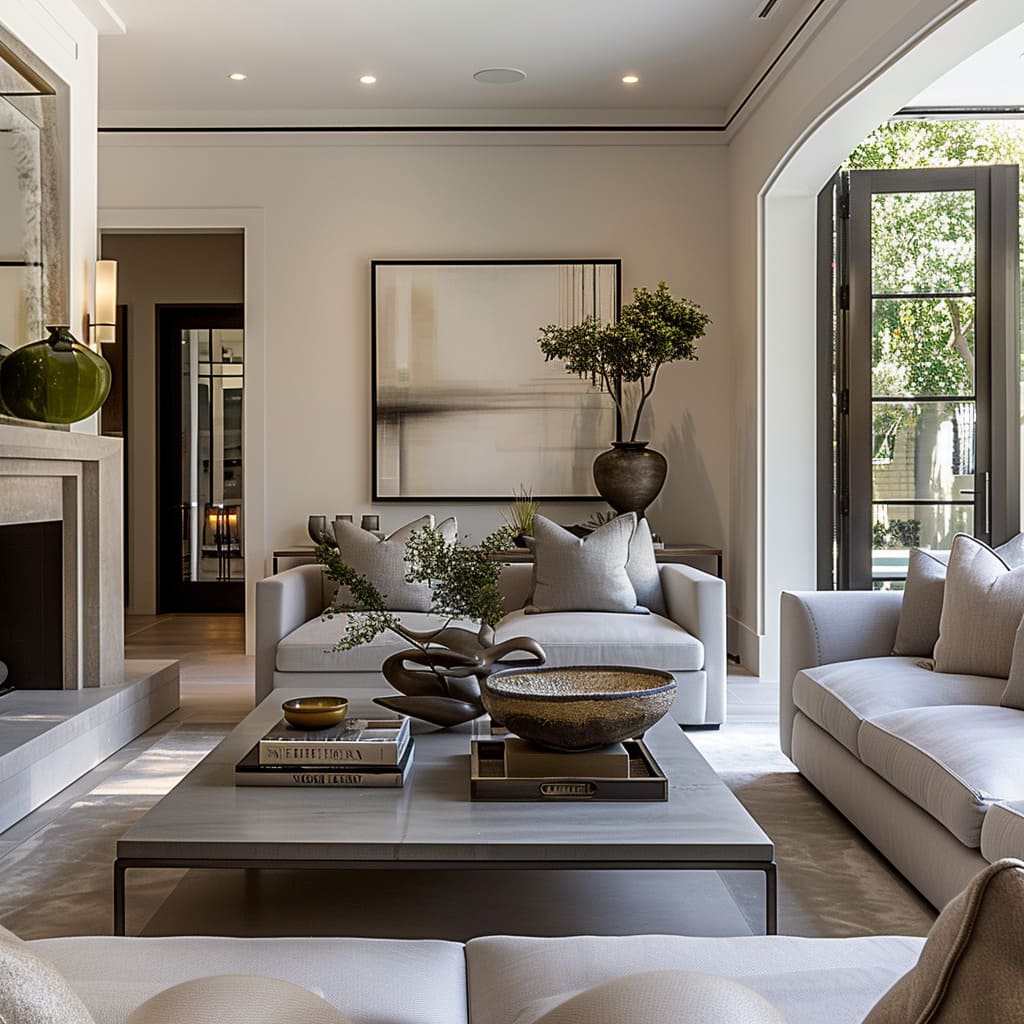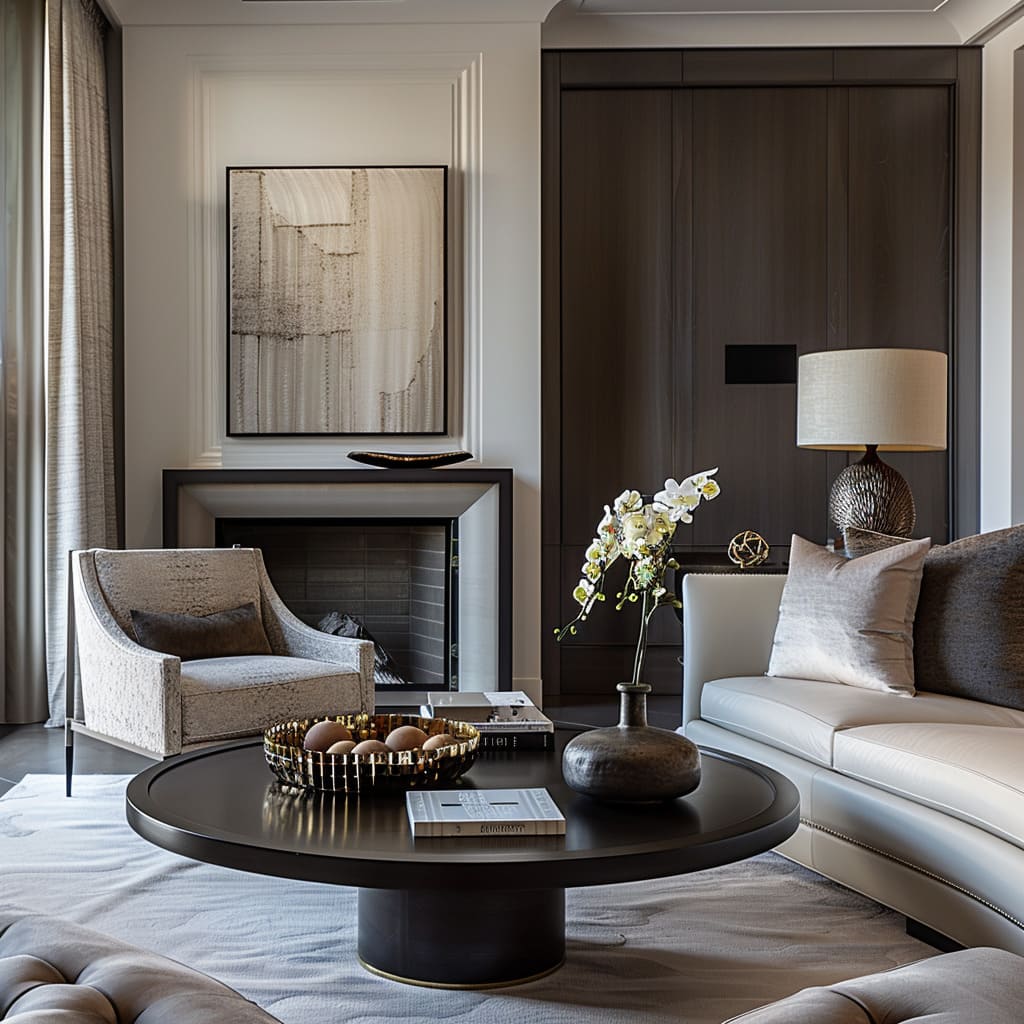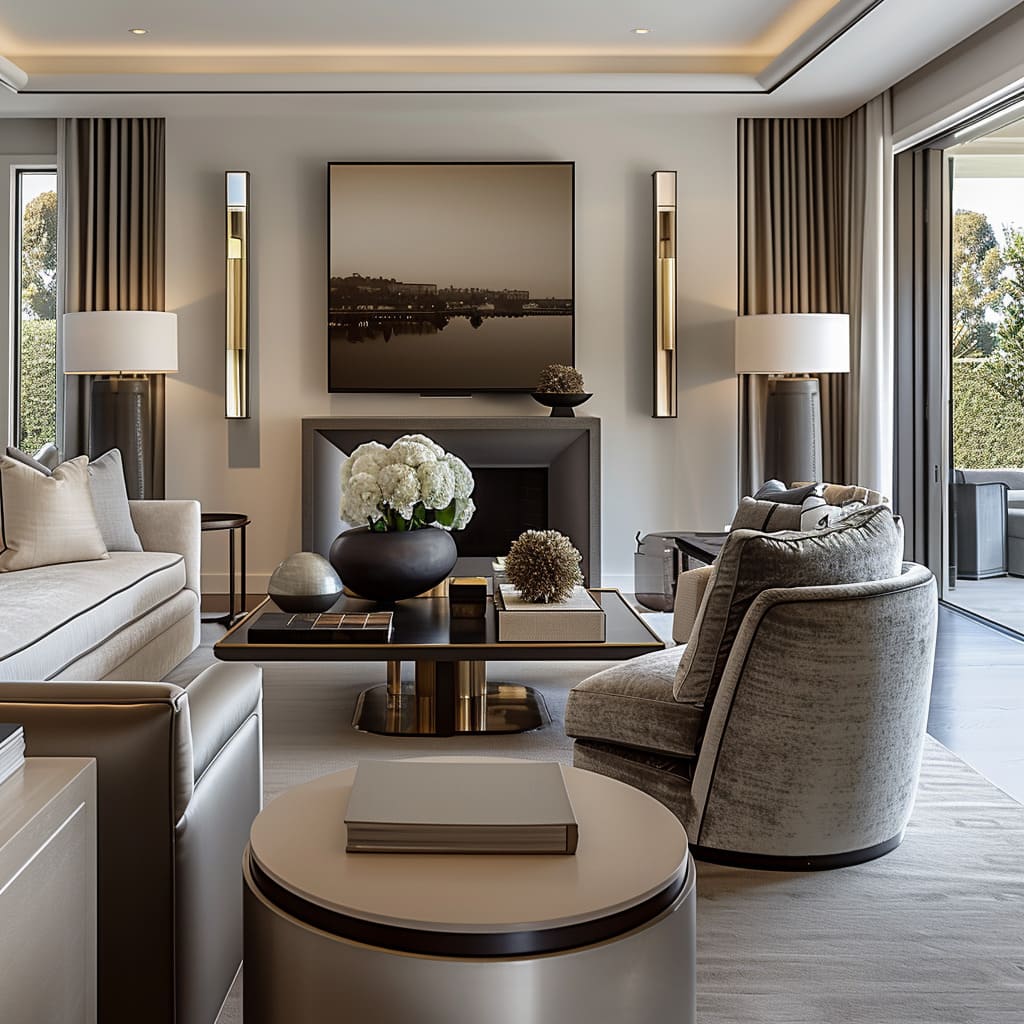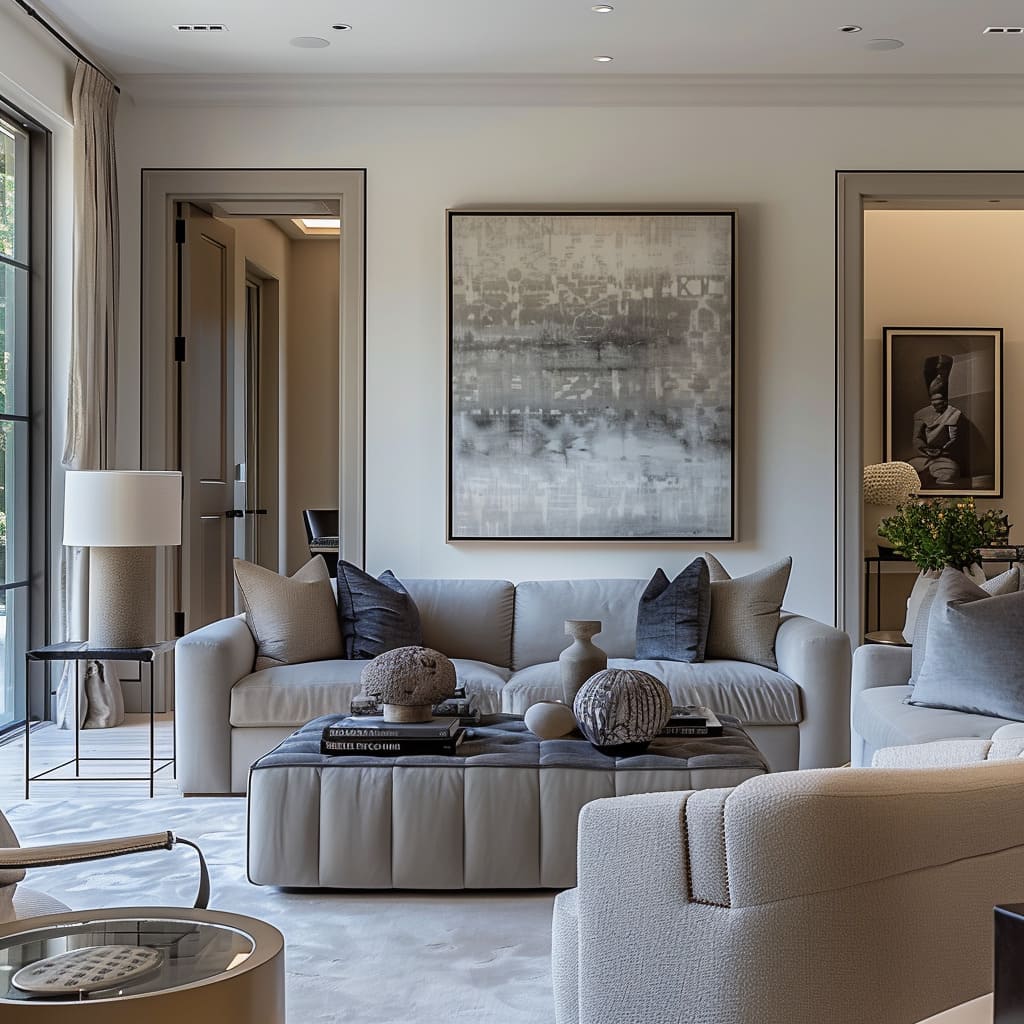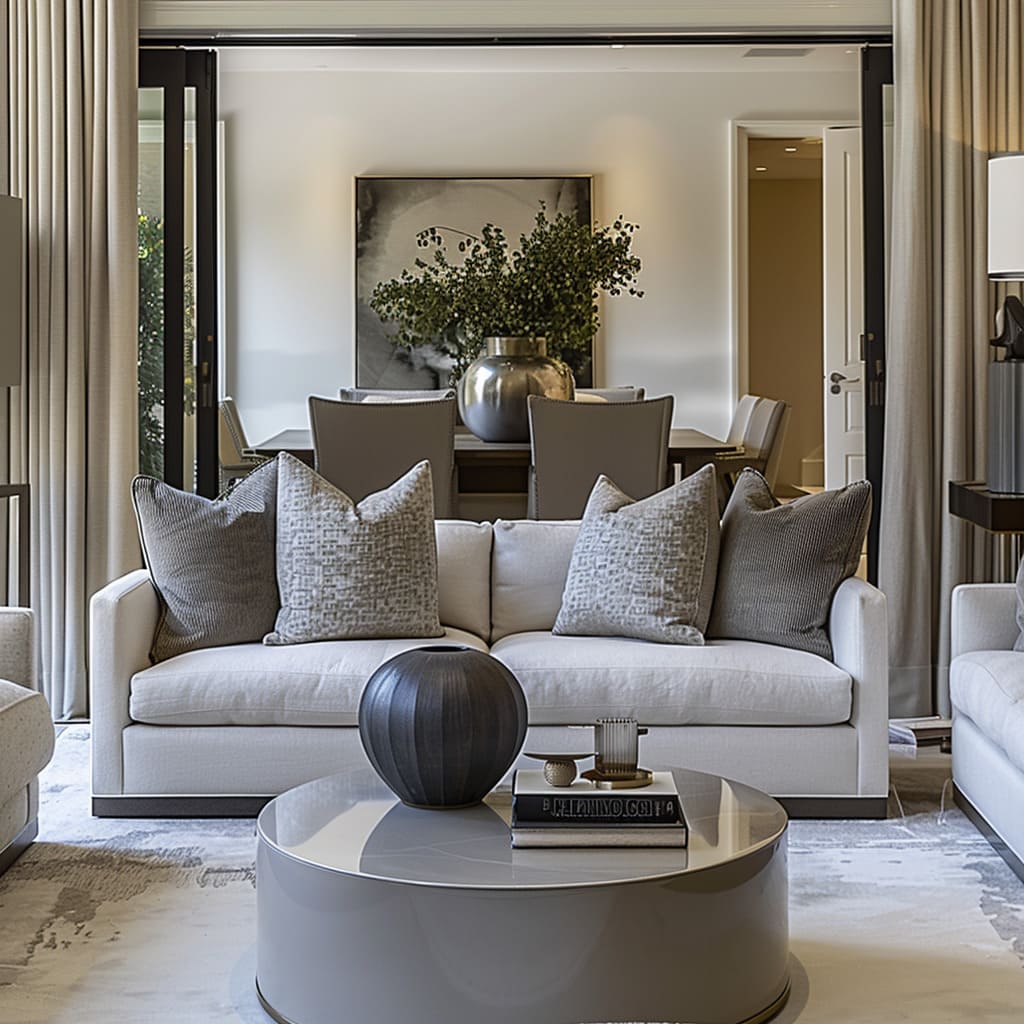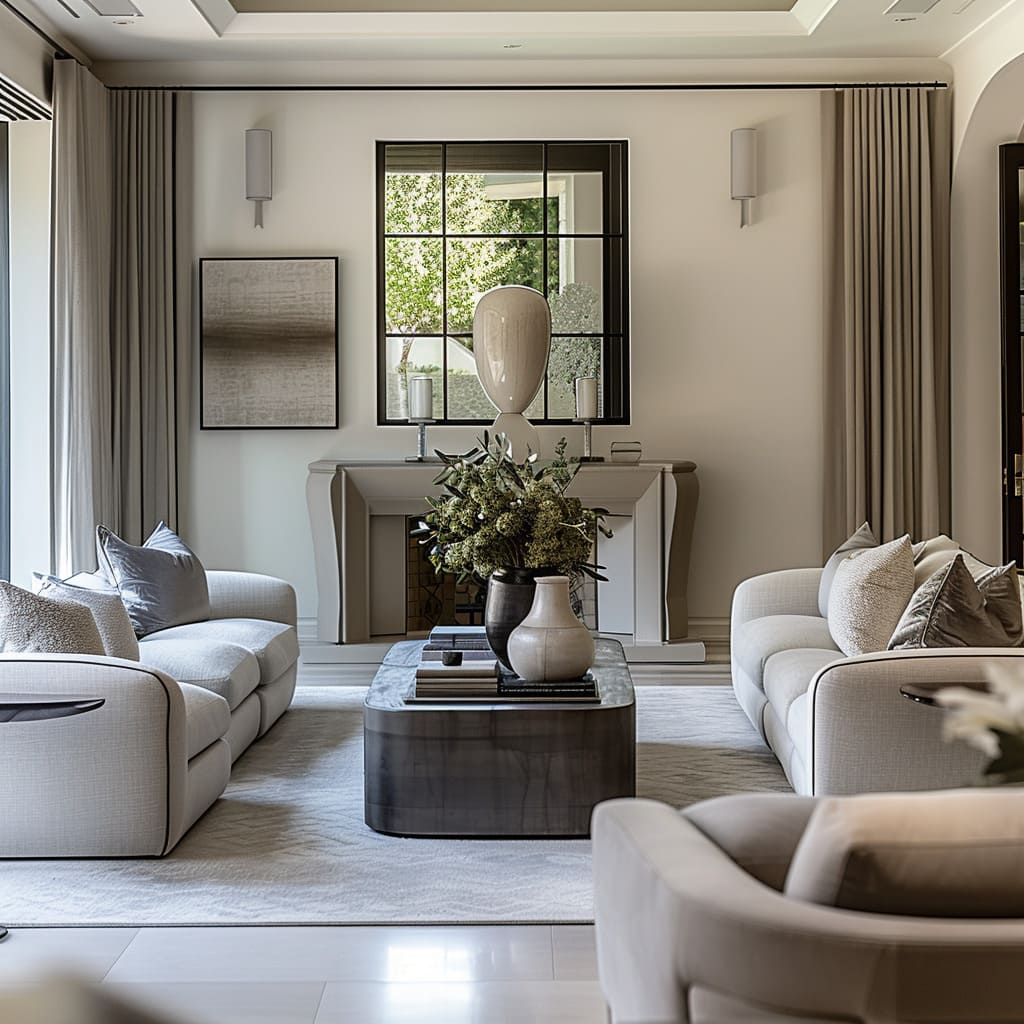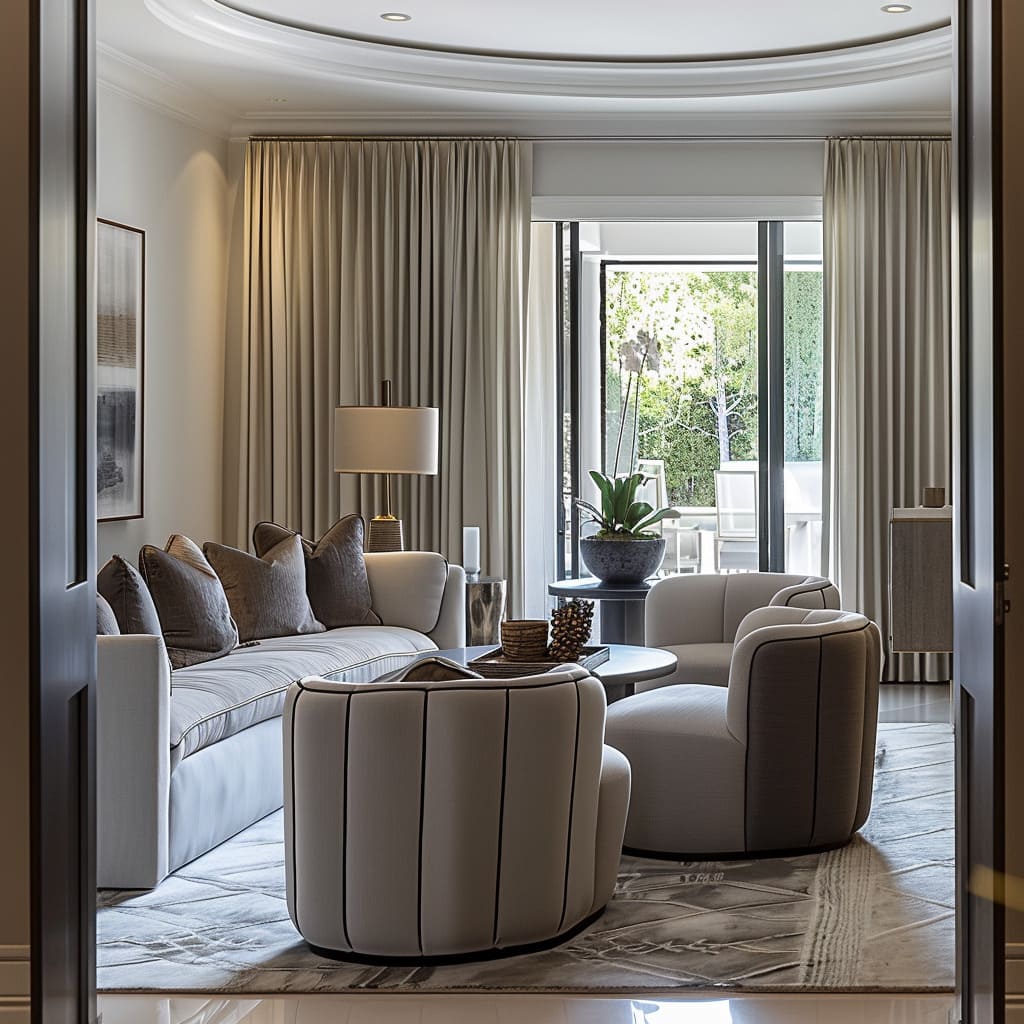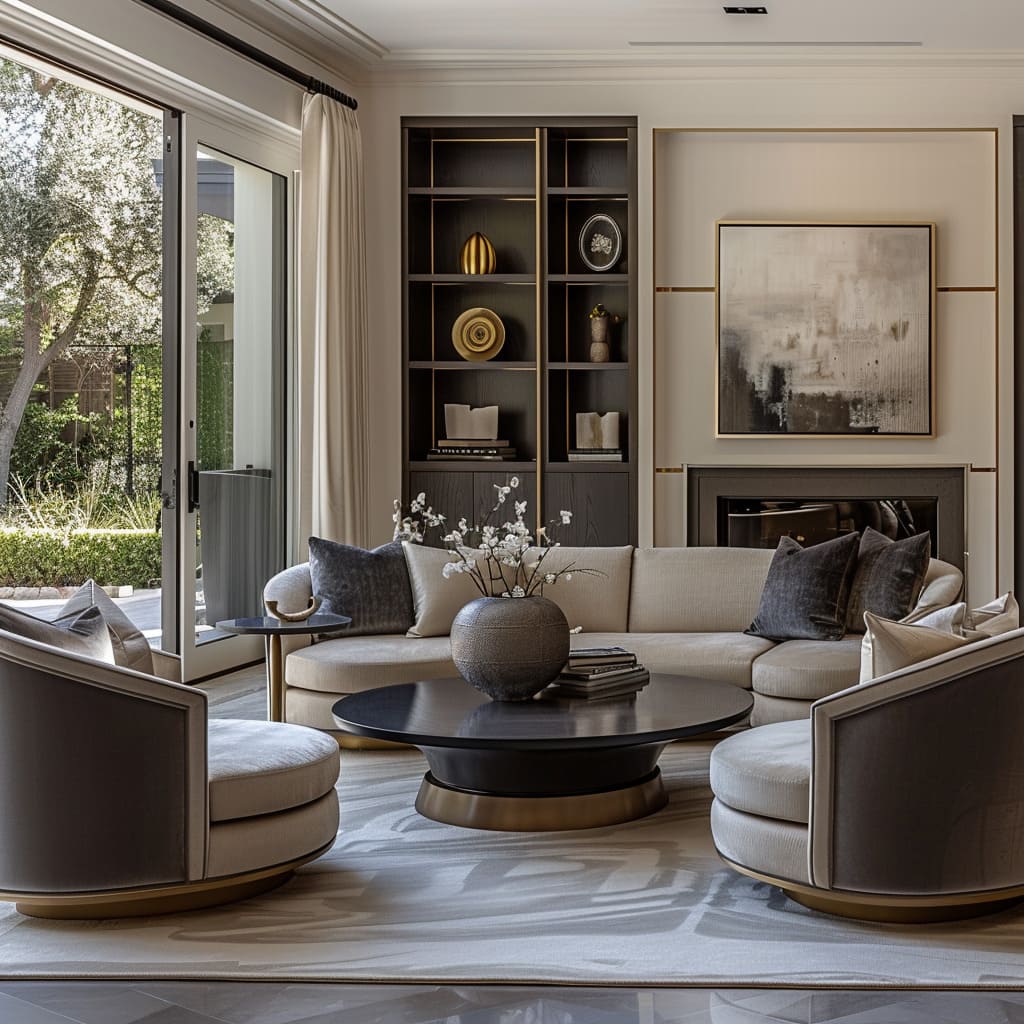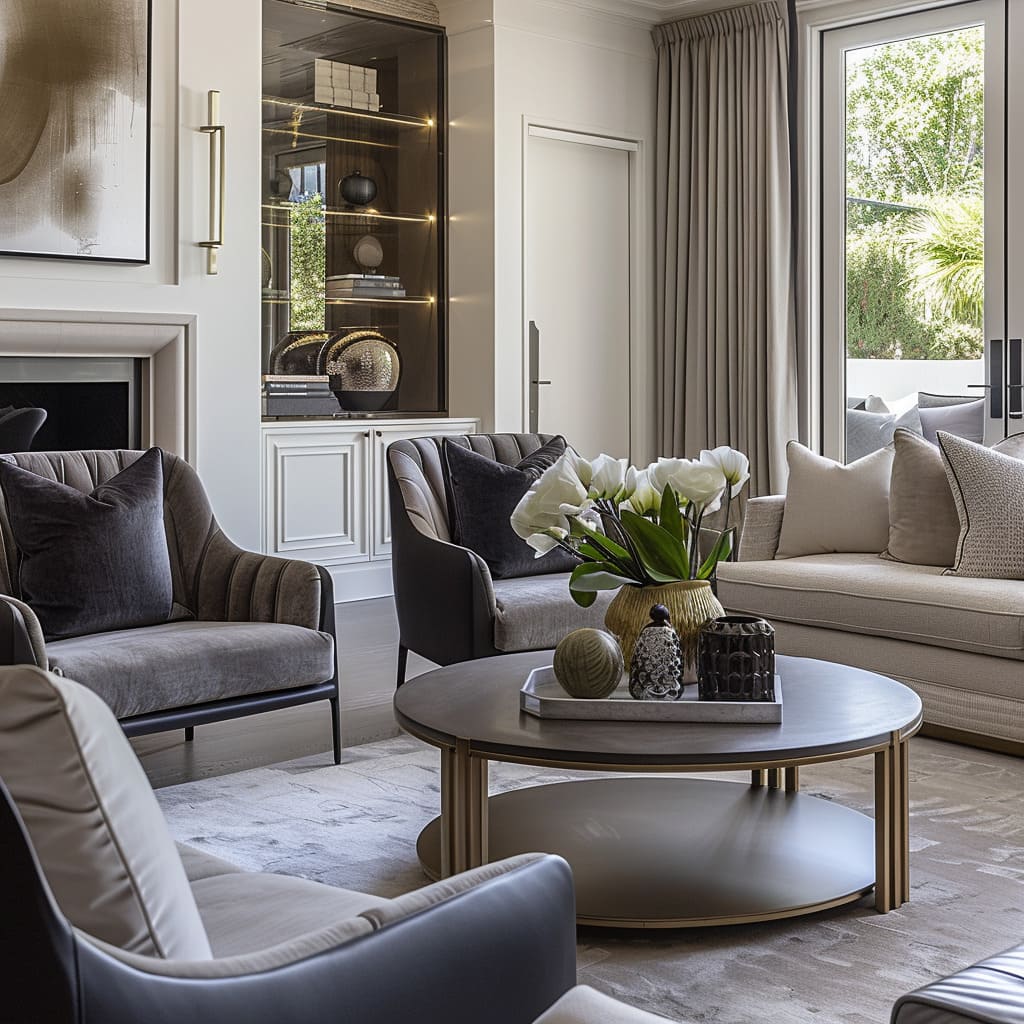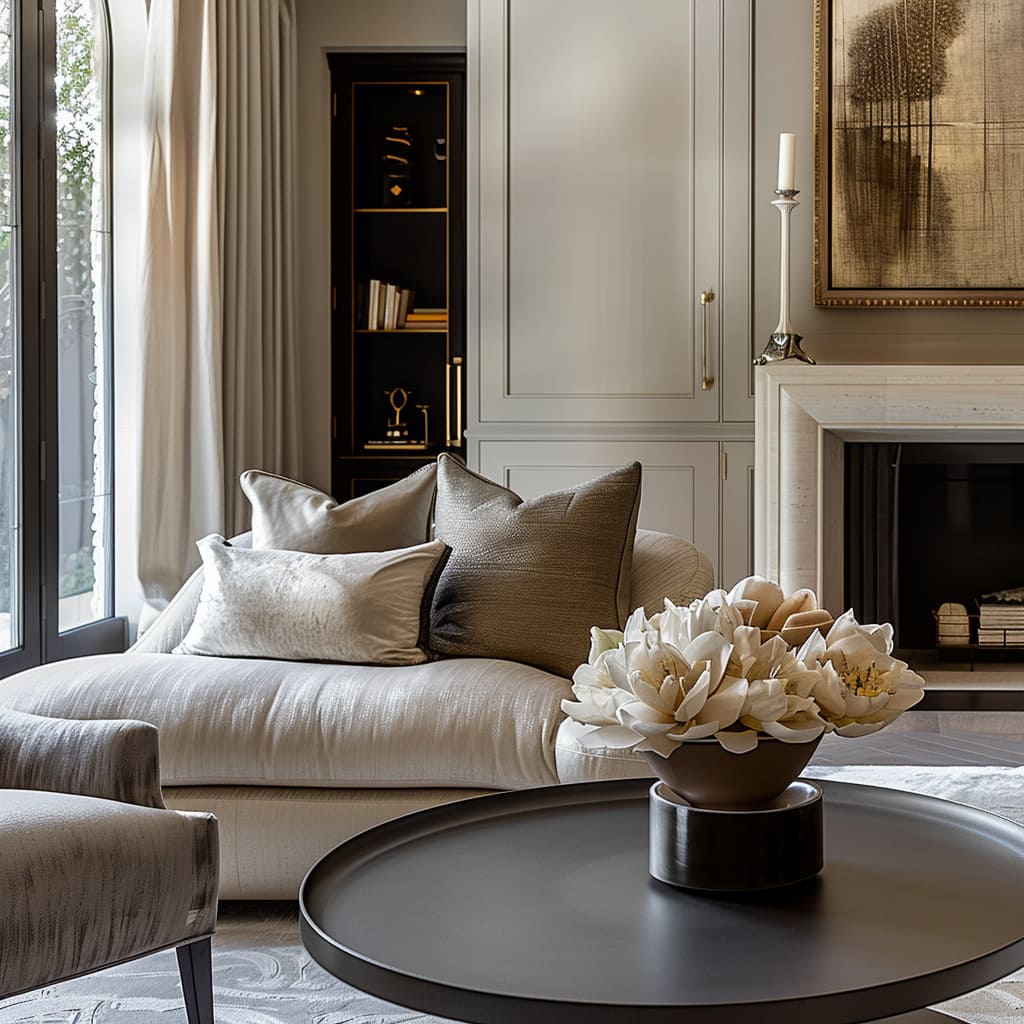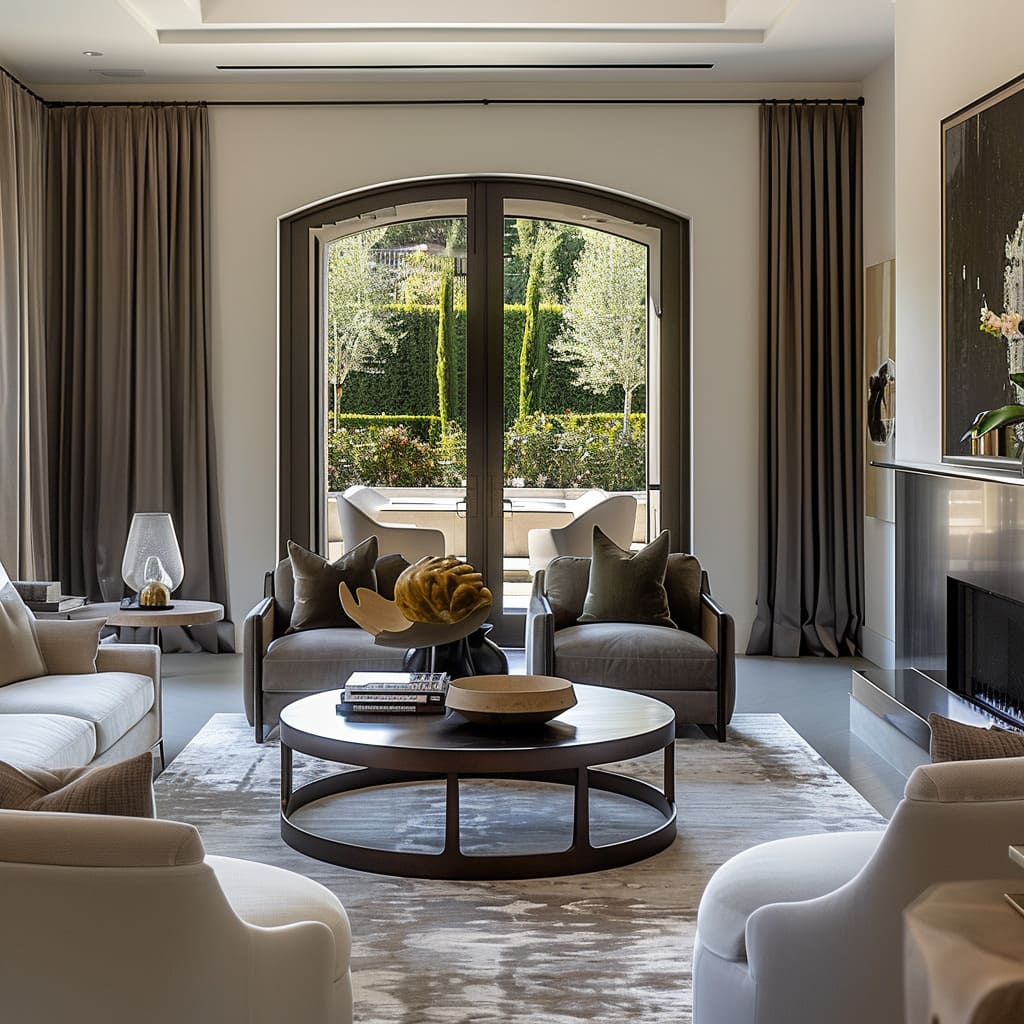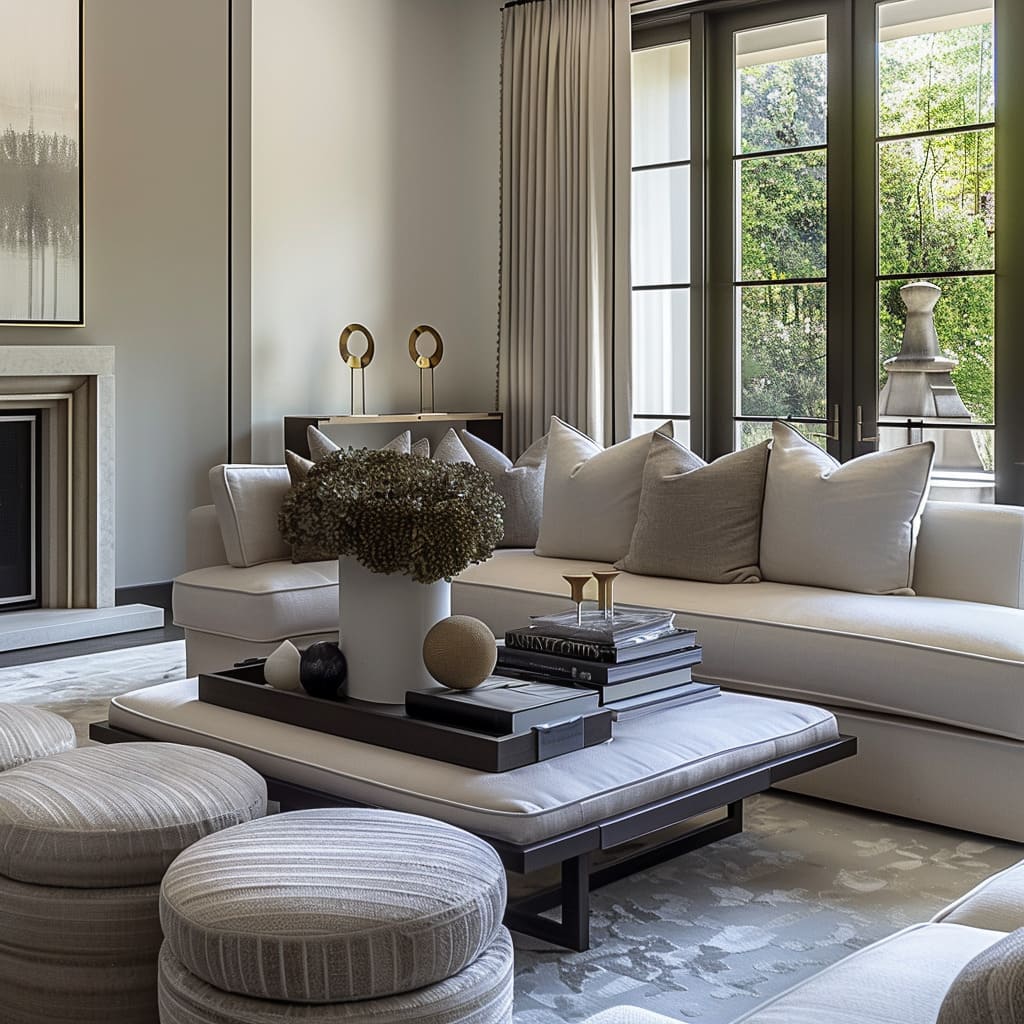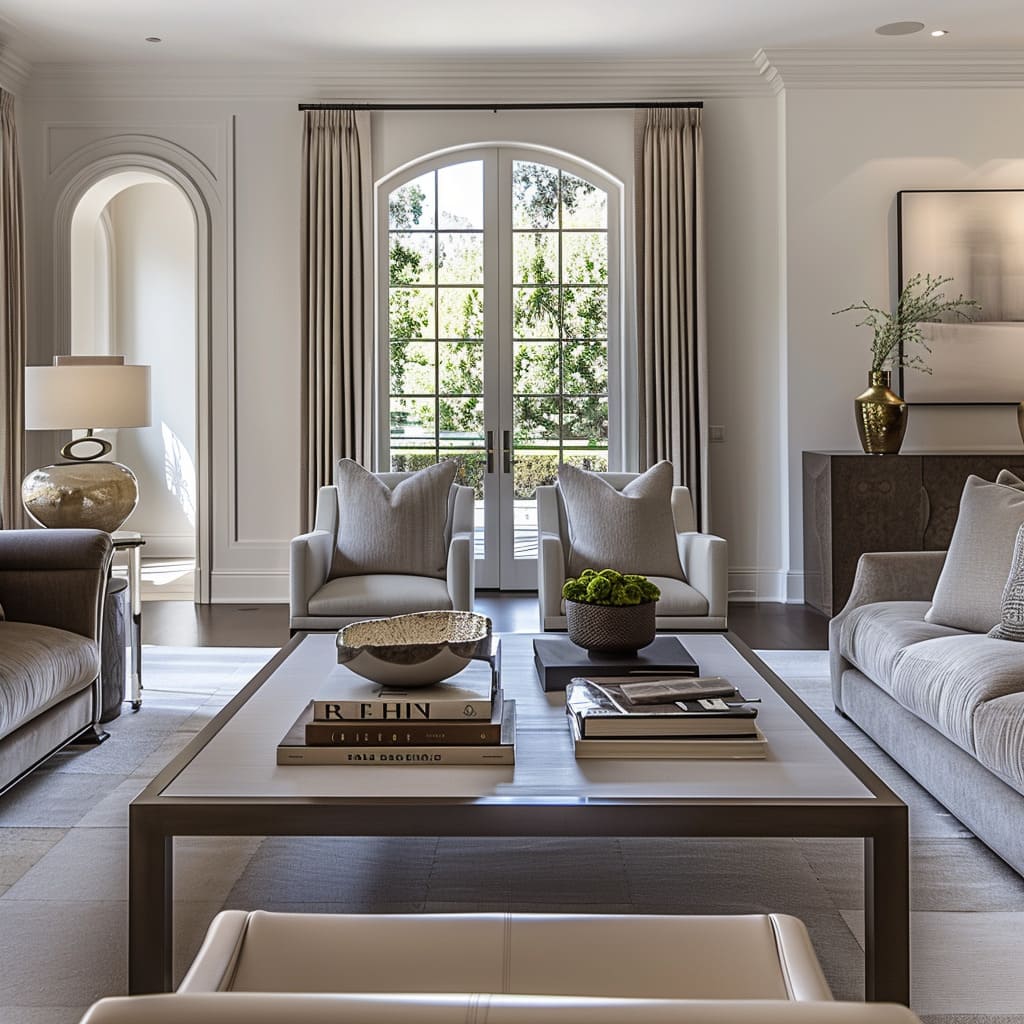In the nuanced world of interior design, each element, from the grandeur of architectural details to the intimacy of a throw blanket, plays a pivotal role in crafting a space’s narrative. This exploration delves into the myriad ways through which design elements like the strategic use of elongated sofas, the artistry in architectural detailing, the dynamic interplay of furniture shapes, and the deliberate creation of vignettes come together to orchestrate a symphony of thematic consistency.
Here, we uncover how the meticulous arrangement of objects, the thoughtful repetition of design elements, and the careful curation of decorative jars and orchids contribute to a coherent aesthetic narrative, transforming spaces into vivid expressions of individuality and intention.
Thematic Consistency
Thematic consistency is the thread that ties all design elements together, creating a cohesive narrative throughout the space. It involves the careful selection of elongated sofas, architectural details, and a mix of furniture shapes to support the chosen theme.
Vignette creation and thoughtful repetition of elements, shapes, or colors reinforce the design’s direction, making the space feel intentional and unified. This consistency ensures that the interior feels harmonious, with each element contributing to a singular vision, resulting in a space that is not only aesthetically pleasing but also tells a coherent story, reflecting the inhabitants’ style and personality.
Elongated Sofas
In these designs, the sofas are not just seating; they are substantial, elongated pieces that anchor the living space. Their generous lengths allow for multiple guests to be seated comfortably, facilitating social gatherings and conversation.
The choice of upholstery on these sofas often features luxurious fabrics that invite touch, such as velvety textures or woven linens, contributing to the room’s tactile experience. The extended length of the sofas is proportionate to the scale of the room, ensuring that they appear as intentional, grand statements within the space.
Their placement is also strategic, often facing significant elements like a fireplace or a grand view, reinforcing their role as a central hub for interaction and relaxation.
Architectural Details in Interior Design
The architectural details in these spaces are crafted with a deep understanding of form and function, creating a unique narrative that underscores the design’s intention. Moldings and cornices are not simply decorative; they frame rooms, draw attention to the height of the ceilings, and accentuate the transitions between walls and floors.
These elements often feature subtle but intricate designs that catch the light and shadow, adding depth and texture to the surfaces. Cornices may be bold, extending into the ceiling space, or they may be fine lines that delicately outline the perimeter of a room.
In some cases, the moldings serve as a foundation for color blocking, with the areas above or below them painted in different hues to create visual interest and delineate spaces within the room.
Mix of Round and Angular Furniture
The interplay of round and angular furniture in these interiors is a deliberate design tactic to create a dynamic and visually stimulating environment. Round tables often serve as a softening element amongst the more rigid lines of angular sofas and vice versa, providing a counterbalance that is both aesthetically pleasing and psychologically comforting.
This contrast is carefully curated; for example, a circular coffee table might be complemented by a rectangular area rug, or an oval mirror may hang above a linear console table.
The choice of round furniture often includes pieces with a sculptural quality that serves as a focal point, while the angular pieces provide structure and grounding to the layout of the room. This balance of forms not only enhances visual interest but also encourages a fluid movement through the space, as the eye naturally transitions from one shape to the next.
Vignette Creation
Vignettes within these interiors are composed with an artist’s eye for detail, each one telling a story or capturing a mood. These small, styled arrangements may feature a collection of items such as a vase, a stack of books, and a sculptural object that together create a point of interest.
The elements in a vignette are selected not only for their individual beauty but for their ability to interact with one another, whether through contrasting textures, complementary colors, or varying heights.
The background against which these vignettes are set is equally important, with the space around them often left clear to allow each grouping to stand out. Vignettes are strategically placed in areas where they can be appreciated up close, such as on coffee tables or within shelving units, inviting interaction and contemplation.
Thoughtful Repetition
In these interiors, repetition is used as a design principle to establish a sense of unity and harmony. It’s not about duplicating items indiscriminately, but rather about repeating certain motifs, textures, or hues that contribute to the design’s cohesiveness.
For example, a particular shape might be echoed in various furnishings throughout the room, such as a series of round pendants mirroring the shape of round ottomans below. Similarly, a texture or material like brushed metal or velvet might be repeated in different elements, tying together discrete pieces such as lamps, frames, or cushions.
Color repetition is also used judiciously, with accents in artworks or textiles subtly appearing in other room components. This careful repetition creates a visual rhythm that makes the space feel considered and complete.
Artful Arrangement of Objects
The strategic grouping of objects in odd numbers is a design principle employed in these interiors to create visual interest and balance. This approach, rooted in the idea that odd numbers are more pleasing and natural to the eye, is applied in various contexts, from the arrangement of cushions on a sofa to the placement of decorative items on a mantle or shelf.
For instance, three vases of varying heights might be clustered on an end table, or a set of five framed photographs could be displayed on a wall, creating a rhythm and a sense of movement. The objects chosen for these groupings are diverse in material, color, and texture, yet they are unified by an underlying theme or design intent, contributing to the room’s cohesive look.
This thoughtful arrangement enhances the aesthetic appeal, drawing the viewer’s eye across the display and adding depth to the space.
Spatial Composition
Spatial composition in interior design is the artful arrangement of the physical components of a space to create harmony, balance, and functionality. It involves the thoughtful positioning of furniture, the strategic use of area rugs to define areas, and the placement of lighting to influence the room’s vertical dynamics.
This category also considers the use of screens and dividers to subtly segment spaces without disrupting the overall flow. High ceilings and deliberate negative space are leveraged to enhance the sense of openness, ensuring the environment feels expansive yet cohesive.
By mastering spatial composition, designers create rooms that are not only beautiful but also intuitively navigable and comfortable for daily living.
Symmetrical Layouts
The symmetrical arrangements in the interiors not only establish a sense of balance but also bring about a calm and ordered atmosphere. This symmetry is often achieved through the positioning of furniture such as sofas facing each other with a central coffee table, creating a mirror image effect.
Decorative elements like matching lamps on identical side tables or pairs of artworks flank a centerpiece, reinforcing the symmetry. The consistent use of symmetry extends to the architecture as well, with evenly spaced windows and doors that align with the furniture layout, resulting in a room that exudes formality and elegance.
Presence of Area Rugs
The area rugs featured in these interior designs are selected with precision, contributing not only to the definition of each space but also adding an element of acoustic comfort by dampening sound. Their textures range from thick, soft piles that invite bare feet to indulge, to flat weaves that provide a subtle visual foundation for the furniture that rests upon them.
The dimensions are carefully chosen to ensure that the rugs anchor the seating areas without overwhelming the floor space. Colors and patterns are restrained, selected to complement the room’s decor while adding interest and warmth, making the rugs an integral part of the design narrative.
Low-hanging Pendant Lamps
Pendant lamps in these spaces are deliberately hung at a height that invites intimacy, creating a cozy atmosphere even in rooms with generous proportions. These fixtures are often in shapes that echo other design elements in the space, whether it’s the roundness of a vase or the angularity of a table edge.
The materials range from translucent glass that offers a soft diffusion of light to more opaque, sculptural forms that make a statement even when unlit. The strategic placement of these lamps is crucial; they are often positioned above key pieces of furniture like dining tables or coffee tables to highlight and bring focus to these gathering places.
Decorative Screens and Room Dividers
Decorative screens and room dividers are employed within these interiors not just as functional elements to delineate spaces, but also as significant design features that enhance the overall aesthetic. These pieces are often crafted from high-quality materials such as fine woods, metals, or frosted glass, and may incorporate intricate patterns or modern geometries that mirror other visual themes in the room.
They stand as semi-permanent fixtures that offer flexibility in space usage, allowing for an open plan to be quickly transformed into more intimate areas as needed. The elegance of these screens lies in their dual role as both artwork and functional furniture, often placed to create a visual break that does not obstruct light or views, ensuring the flow of the space remains uninterrupted.
High Ceilings
The high ceilings of these rooms are a defining architectural feature, offering a vertical expanse that contributes to a sense of grandeur and freedom. This verticality is often emphasized by the use of tall windows or artfully placed decor that draws the eye upward, making the space feel even larger.
The treatment of the ceilings themselves can be a design highlight, with some featuring intricate moldings, recessed lighting, or architectural beams that add character and detail.
The choice of light fixtures hanging from these high ceilings is also deliberate, serving to bridge the gap between the living space and the expansive overhead area, ensuring that the volume of the room is felt but not overwhelming. These high ceilings also allow for greater natural light penetration, which plays off the interior materials and finishes, enhancing the room’s ambiance throughout the day.
Deliberate Negative Space
The use of negative space in these designs is a strategic choice that speaks to an understanding of visual rest and compositional balance. Instead of filling every corner with objects, the designers leave open areas that allow the room to breathe and the eye to move freely.
This considered approach to spacing means that furniture and decor are given room to stand out, with each piece afforded its own area of prominence without competition. The negative space acts as a visual palate cleanser, emphasizing the beauty and intention behind each chosen element.
In areas where activity is frequent, such as near seating arrangements or pathways, the negative space also serves a functional purpose, allowing ease of movement and flow throughout the room.
Functional Aesthetics
Functional aesthetics blend the beautiful with the practical, ensuring that every design element serves a purpose beyond mere decoration. This approach includes the strategic placement of books, unified color schemes in furnishings, and elegant fireplaces that provide warmth and serve as focal points.
Trays, sleek window frames, and semi-hidden storage solutions embody the principle that design should simplify and enhance daily living. By integrating functional aesthetics, spaces become more than just visually pleasing—they become practical environments that cater to the needs and comfort of the occupants, marrying form with function in seamless harmony.
Use of Books as Decor
The books displayed in these spaces are far from random; they are curated collections that reflect the homeowner’s interests and serve as a sophisticated backdrop. They are often hardbound volumes with spines that bring a variety of muted colors to the room, sometimes arranged by color to create a visually pleasing gradient.
Coffee table books are prominently displayed, their large format and striking covers acting as a subtle invitation to browse through them. On shelves, books are interspersed with other decorative items, suggesting a lived-in space that values culture and learning, while also contributing to the room’s aesthetic.
Unified Color Schemes for Furnishings
The furniture throughout these interiors showcases a commitment to a unified color scheme that creates a thread of continuity from room to room. This does not mean that each piece is identical in shade; rather, there is a family of colors that are skillfully played against each other.
For example, a variety of grays might be used, ranging from charcoal to silver, but all maintaining a cohesive narrative. The fabrics and finishes of the furniture pieces are chosen to reflect light similarly, ensuring that the pieces all feel part of the same story.
Even where contrast is introduced, it is done so with a careful hand, ensuring that the overarching harmony of the space is preserved.
Elegant Fireplace Designs
The fireplace designs within these spaces are the epitome of elegance, often acting as the architectural anchor of the room. They are crafted from materials that complement the color palette, such as marble, stone, or refined metals, with mantelpieces that are either sleekly modern or traditionally ornate to match the room’s style.
Beyond their visual appeal, these fireplaces are designed to be functional, with some housing gas inserts for ease of use or featuring sophisticated glass enclosures that amplify the dance of the flames. The fireplaces are also strategically positioned to be visible from multiple vantage points within the room, ensuring that the warmth and light they provide enhance the ambiance of the entire space.
Use of Trays on Tables
Trays on tables are an understated but essential element of the design. They serve to corral and organize, creating neat, designated spaces for collections of items that might otherwise clutter a surface.
Whether holding a set of designer coasters, an array of candles, or a collection of curated decorative objects, trays add a layer of intentionality to the decor. The materials of these trays — from polished wood to mirrored glass — are chosen to reflect the textures and tones of the room.
They also function as a platform for showcasing small personal artifacts or seasonal decorations, allowing for an easy refresh of the decor with minimal effort. The careful arrangement of items on these trays is a testament to the meticulous attention to detail prevalent in the overall design approach.
Sleek Window Frames
In these designs, window frames are more than just functional elements; they are integral to the room’s design and serve to frame the outside world as if it were a piece of live artwork. The frames are often minimalistic, with clean lines that avoid any ornamental distraction, allowing the focus to remain on the view outside.
The materials used are chosen for their durability and finish, which might be matte, brushed, or anodized, and are color-matched with the walls or contrasting subtly to draw attention to the windows. The sleekness of the frames contributes to a modern, uncluttered look that aligns with the overall design ethos of simplicity and sophistication.
Semi-hidden Storage Solutions
Storage solutions in these spaces are ingeniously integrated, designed to blend seamlessly with the environment. They may take the form of built-in cabinets that maintain the same finish as the walls, making them almost indiscernible at first glance.
Drawers and shelving are frequently constructed within larger pieces of furniture like beds or ottomans, providing a dual function without compromising on style. The handles and hardware are often recessed or designed to be unobtrusive, maintaining the clean lines and minimalist feel of the room.
These storage options are strategically placed to maintain the balance between aesthetics and functionality, ensuring that the space remains uncluttered and serene.
Low-profile Shelving Units
Shelving units in these designs are a study in discretion and functionality. They are built close to the walls and are often of the same color or finish to blend into the background subtly.
The shelves themselves are not overly deep, which encourages minimalistic displays and discourages clutter. Their low height often parallels the line of sight, ensuring that the overall view of the space is unobstructed and open.
These units might house a select few decorative items, each chosen for its contribution to the room’s narrative, allowing for both display and storage without compromising the space’s sleek appearance.
Sophisticated Coffee Table Books
The coffee table books featured in these designs are much more than casual reading material; they are curated to reflect the homeowner’s tastes and interests, serving as both intellectual engagement and visual delight. Their covers are often works of art themselves, carefully selected to resonate with the color scheme and thematic elements of the room.
These books are usually large and prominently placed, often stacked to create levels of height or fanned out for guests to peruse. Their subject matter—whether it’s a retrospective of a renowned fashion designer, an exploration of modern architecture, or a visual journey through exotic locations—serves to underline the worldly and refined character of the living space.
Designer Tableware
The selection of tableware in these spaces goes beyond functionality to serve as a testament to the homeowner’s appreciation for fine design. Each piece of designer tableware is chosen not only for its brand recognition but for its aesthetic contribution to the space.
From sleek, contemporary lines to classic, elegant forms, these pieces often display a subtle sophistication that matches the overarching theme of the interiors. Placed intentionally on open shelving or within glass-fronted cabinets, the tableware becomes a part of the room’s decor, reflecting the same meticulous attention to detail and quality that is evident throughout the space.
Even in storage, these items are arranged to be visually appealing, with the gleam of fine porcelain or the shimmer of crystal adding a sense of opulence to the room.
Decorative Elements
Decorative elements are the jewels of interior design, providing beauty, character, and personalization to a space. This category encompasses the use of accent chairs, throws, cushions, and sculptural pieces to inject personality and style.
Neutral-toned drapery, vases, bowls, and art pieces contribute to the room’s aesthetic allure, each element carefully chosen to complement the overall design theme. These components are not merely ornamental; they play a crucial role in bringing the design to life, offering visual interest and a sense of luxury that makes a space feel complete and inviting.
Accent Chairs
Accent chairs are not merely additional seating; they are chosen for their distinctive design that complements the overall decor. These chairs often feature unique shapes or materials that make them stand out, yet they harmonize with the room’s color palette.
For instance, a plush, velvet accent chair might introduce a touch of luxury, or a chair with a sculptural form might serve as a statement piece. Positioned to complete seating arrangements or to fill an otherwise empty corner, these chairs add depth to the room’s design, while their strategic placement contributes to the functionality and flow of the space.
Use of Throws and Cushions
Throws and cushions scattered across the seating furniture serve multiple purposes. They are thoughtfully chosen to provide an additional layer of texture and color, often featuring materials that contrast with the upholstery, such as a knitted throw against a smooth leather sofa.
These accessories are arranged to look effortlessly chic, yet they also invite occupants to settle in and get comfortable. Color contrasts are subtle but deliberate, with hues that echo other elements in the room, such as wall art or rugs.
This careful selection and placement of throws and cushions enhance the overall comfort and aesthetic appeal of the room.
Sculptural Pieces
Sculptural pieces in these interiors are not just decorative; they are integral to the design language, often handpicked to resonate with the space’s architectural features or design motifs. They might range from abstract forms that provide a modern counterpoint to the traditional elements of the room, to more figurative pieces that add a touch of whimsy or personal storytelling.
These sculptures are positioned to draw the eye, often in locations that are passed by or viewed frequently, ensuring they engage and delight onlookers. The materials of the sculptures — whether metal, stone, glass, or wood — are chosen to add another layer of textural interest and to interact playfully with the natural and artificial light within the space.
Neutral-toned Drapery
The drapery in these interiors is selected with a thoughtful approach to both function and style. The neutral tones of the curtains are chosen to harmonize with the walls and furniture, ensuring a seamless visual experience that enhances the room’s tranquility.
These drapes are often of a substantial weight, hinting at their quality and contributing to the insulation and acoustics of the space. The length of the curtains is tailored to create a sense of height, with some designs just kissing the floor and others pooling slightly for a touch of opulence.
Hardware from which the drapery hangs is minimalist and often hidden, allowing the fabric itself to take center stage, framing windows with a quiet, understated luxury.
Incorporation of Vases and Bowls
Vases and bowls within these interior designs are chosen for their shapes, textures, and the interplay of materials they bring to the space. They are often in understated hues that fit the neutral palette but may have a textural or reflective finish that adds subtle sophistication.
These pieces are not randomly placed; they are carefully positioned to draw attention to particular areas, like a centerpiece on a dining table or a statement piece on a mantel. They may be used to hold floral arrangements that bring a touch of nature indoors or left empty as sculptural elements in their own right.
The selection of vases and bowls often reflects an artistic sensibility, with each piece chosen for its ability to contribute to the room’s aesthetic narrative.
Monochromatic Art Pieces
The art pieces selected for these interiors adhere to a monochromatic color scheme that not only complements but also enhances the room’s design through a sophisticated play of shades and tones. This thoughtful choice ensures that the artwork integrates smoothly without dominating the space, providing a visual rest and continuity.
The textures and finishes of these pieces vary, some boasting a glossy sheen that reflects light, while others possess a matte surface that absorbs it, adding depth and dimension to the walls. The scale of the artwork is also considered, with some pieces sized to serve as a backdrop for a seating arrangement or to anchor a dining area, further tying the room’s elements together.
Incorporation of Throw Blankets
Throw blankets in these interior spaces serve as an invitation to comfort and relaxation. Their placement is intentional, with each blanket draped over an armrest or the back of a sofa in a way that suggests casual use.
These blankets are often chosen for their luxurious materials, such as cashmere or mohair, which not only add warmth but also a rich texture that contrasts with the upholstery. The colors and patterns of the throw blankets are carefully selected to complement the room’s color palette or to add a pop of visual interest without overwhelming the design.
They also serve a practical function, easily accessible for those chilly evenings or simply when a soft, cozy touch is desired. The thoughtful incorporation of throw blankets adds a layer of lived-in warmth that makes the spaces feel like home.
Decorative Jars and Canisters
In these interiors, decorative jars and canisters are selected with an eye for detail and a nod to both functionality and form. They are often crafted from materials like ceramic, glass, or metal, featuring intricate designs, textures, or finishes that complement the room’s aesthetic.
These containers serve multiple purposes they can store everyday items, reducing clutter, or they might hold collections of curated objects like seashells, stones, or dried botanicals, adding a personal touch to the space.
Placed strategically on open shelving, countertops, or side tables, these jars and canisters act as visual anchors, drawing the eye and providing a sense of order and intentionality. The choice of these items reflects the overall design scheme, whether they are minimalist and monochromatic to suit a contemporary space or more ornate to align with a traditional decor.
Potted Orchids
Orchids are a favored choice in these settings, not just for their exotic beauty but for the elegance and sophistication they lend to any interior. Often housed in sleek, stylish vases or pots, these orchids are chosen to complement the interior’s color scheme and design aesthetic.
The pots themselves are part of the decor, with materials ranging from polished ceramic to textured stone, and they are placed in areas where they can be appreciated, such as on coffee tables, in niches, or on window sills. Orchids provide a burst of natural beauty and a touch of serenity, their delicate blooms and graceful stems adding a refined, organic element to the rooms.
They are often used as a focal point or as a way to introduce a subtle splash of color in otherwise monochromatic spaces.
As we conclude our journey through the tapestry of interior design, it becomes evident that the creation of a space is akin to a meticulous choreography where every element, from the eloquent language of architectural details to the subtle whispers of decorative objects, contributes to the overall narrative. The strategic symphony of elongated sofas, the calculated harmony of round and angular furniture, and the thoughtful placement of artful vignettes all play their parts in achieving thematic consistency.
This exploration reveals how the integration of various design elements, each with its own voice and story, culminates in the creation of spaces that are not just visually stunning but are imbued with a sense of purpose and identity. Through the lens of design, we see how spaces can become reflections of ourselves, narratives woven from the very fabric of our tastes, experiences, and aspirations.


